|
|
Cessna
The Cessna Aircraft Company is an American general aviation aircraft manufacturing corporation headquartered in Wichita, Kansas. Best known for small, piston-powered aircraft, Cessna also produces business jets. The company is a subsidiary of the U.S. conglomerate Textron.
Clyde Cessna, a farmer in Rago, Kansas, built his own aircraft and flew it in June 1911, the first person to do so between the Mississippi River and the Rocky Mountains. Cessna started his wood-and-fabric aircraft ventures in Enid, Oklahoma, testing many of his early planes on the salt flats. When bankers in Enid refused to lend him more money to build his planes, he moved to Wichita. Cessna Aircraft was formed when Clyde Cessna and Victor Roos became partners in the Cessna-Roos Aircraft Company in 1927. Roos resigned just one month into the partnership selling back his interest to Cessna. In the same year, the Kansas Secretary of State approved dropping Roos's name from the company name. The Cessna DC-6 earned certification on the same day as the stock market crash of 1929, 29 October 1929. In 1932 Cessna Aircraft Company closed its doors due to the Great Depression. However, the Cessna CR-3 custom racer took its first flight in 1933. The plane won the 1933 American Air Race in Chicago and later set a new world speed record for engines smaller than 500 cubic inches by averaging 237 mph (381 km/h). Cessna's nephews, Dwane Wallace and his brother Dwight, bought the company from Cessna in 1934. Cessna returned to commercial production in 1946, after the revocation of wartime production restrictions. In 1956 Cessna introduced the Cessna 172, which became the most produced airplane in history.
In 1960 Cessna affiliated itself with Reims Aviation of Reims, France. In 1989 Reims Aviation bought back all the shares held by Cessna.
Cessna's first business jet, the Cessna Citation I performed its maiden flight on 15 September 1969. In 1985 Cessna ceased to be an independent company, it was purchased by General Dynamics Corporation and became a wholly owned subsidiary. In January 1992 it was sold to Textron and in March 2014 Cessna became a brand of Textron Aviation.
150 | 172 |
182 | 206 |
208 | 210 |
310 |
318 |
336/337 Skymaster | O-2 |
340 |
402 | 421
Citation |
500/501 | 510 |
525 | 525A |
525B | 525C |
550 |
560 | 560XL |
650 | 680 |
680A | 750
Cessna 150
The Cessna 150 is a two-seat tricycle gear general aviation airplane that was designed for flight training, touring and personal use.
The Cessna 150 is the fifth most produced civilian plane ever, with 23,839 aircraft produced. The Cessna 150 was offered for sale in the 150 basic model, Commuter, Commuter II, Patroller and the aerobatic Aerobat models. Development started in the mid-1950s and production in September 1958.
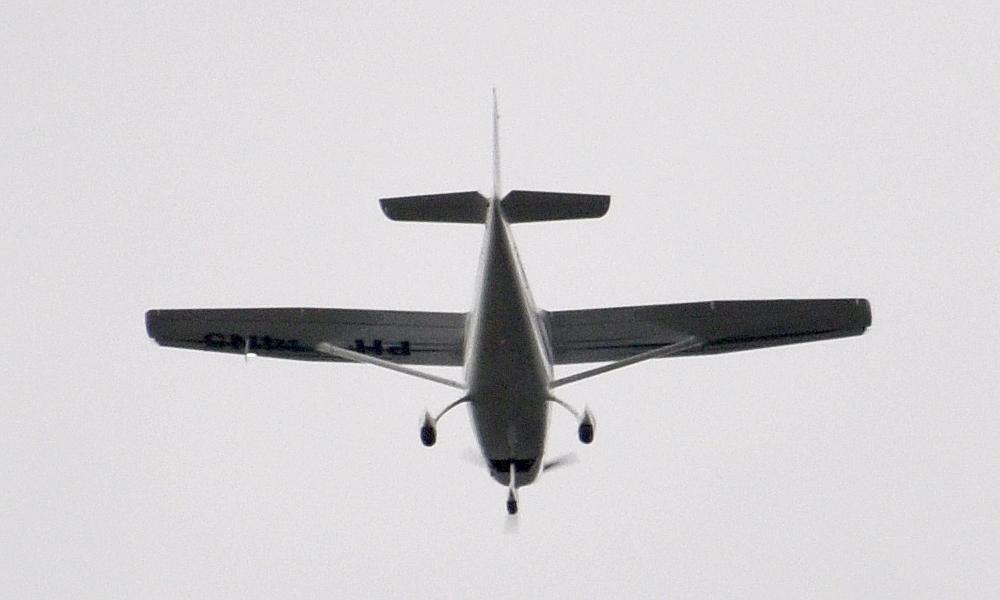
Cessna 150M, registration PH-ANJ, built 1975-1977, serial number 150-77028
Nijmegen, Netherlands, 29 August 2016
150 | 172 |
182 | 206 |
208 | 210 |
310 |
318 |
336/337 Skymaster | O-2 |
340 |
402 | 421
Citation |
500/501 | 510 |
525 | 525A |
525B | 525C |
550 |
560 | 560XL |
650 | 680 |
680A | 750
Cessna 172 Skyhawk
The Cessna 172 Skyhawk is a four-seat, single-engine, high wing, fixed-wing aircraft. First flown in 1955, Cessna delivered the first production models in 1956. As of 2015, Cessna and its partners had built more than 43,000, more than any other aircraft. The Skyhawk's main competitors have been the Beechcraft Musketeer and Grumman AA-5 series (neither currently in production), the Piper Cherokee, and, more recently, the Diamond DA40.
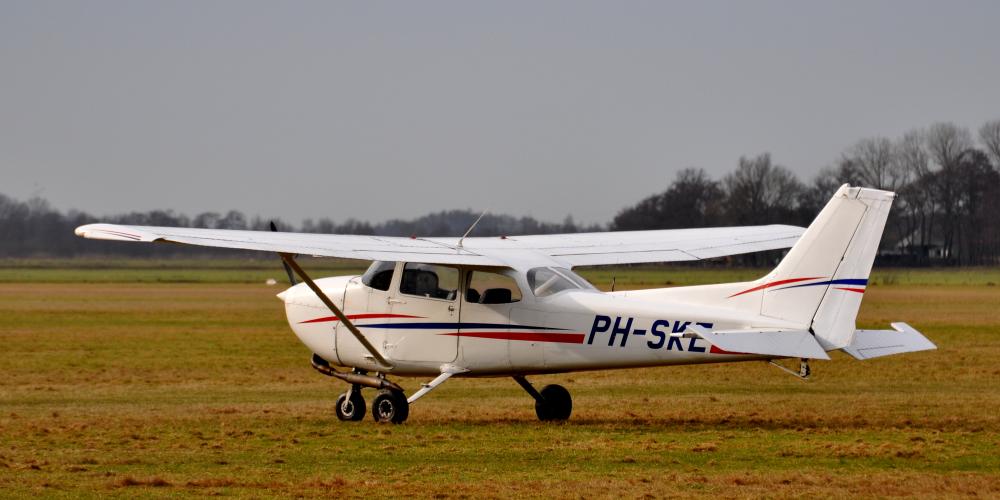
Cessna 172P Skyhawk, registration PH-SKE, built 1981, serial number 172-74730
Vliegveld Hilversum (EHHV), Hilversum, Netherlands, 4 February 2017
150 | 172 |
182 | 206 |
208 | 210 |
310 |
318 |
336/337 Skymaster | O-2 |
340 |
402 | 421
Citation |
500/501 | 510 |
525 | 525A |
525B | 525C |
550 |
560 | 560XL |
650 | 680 |
680A | 750
Cessna 182 Skylane
The Cessna 182 Skylane is a four-seat, single-engined light airplane. It has the option of adding two child seats, installed in the baggage area. Introduced in 1956, the 182 has been produced in a number of variants, including a version with retractable landing gear, and is the second most popular Cessna model, after the 172.
Variant T182T Skylane is a four-seat light aircraft with fixed landing gear, powered by a turbocharged and fuel-injected 235 hp (175 kW) Lycoming TIO-540-AK1A piston engine. Certified on 23 February 2001.
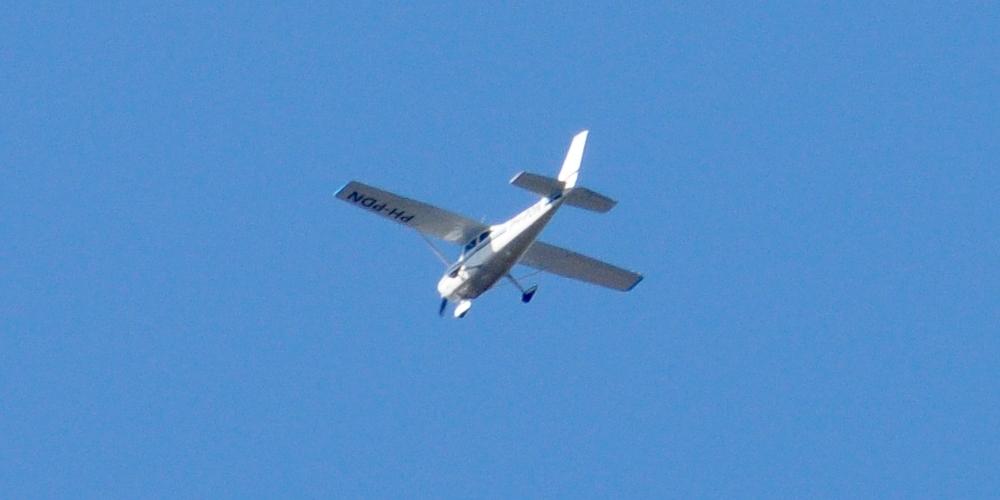
Cessna 182P Skylane, registration PH-PDN, built 1977, serial number 182-62694
Nijmegen, Netherlands, 23 April 2016
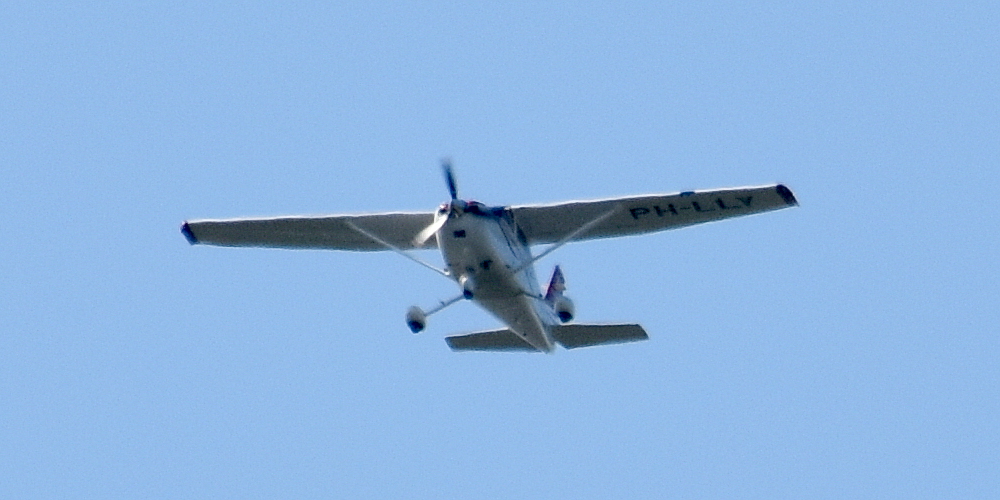
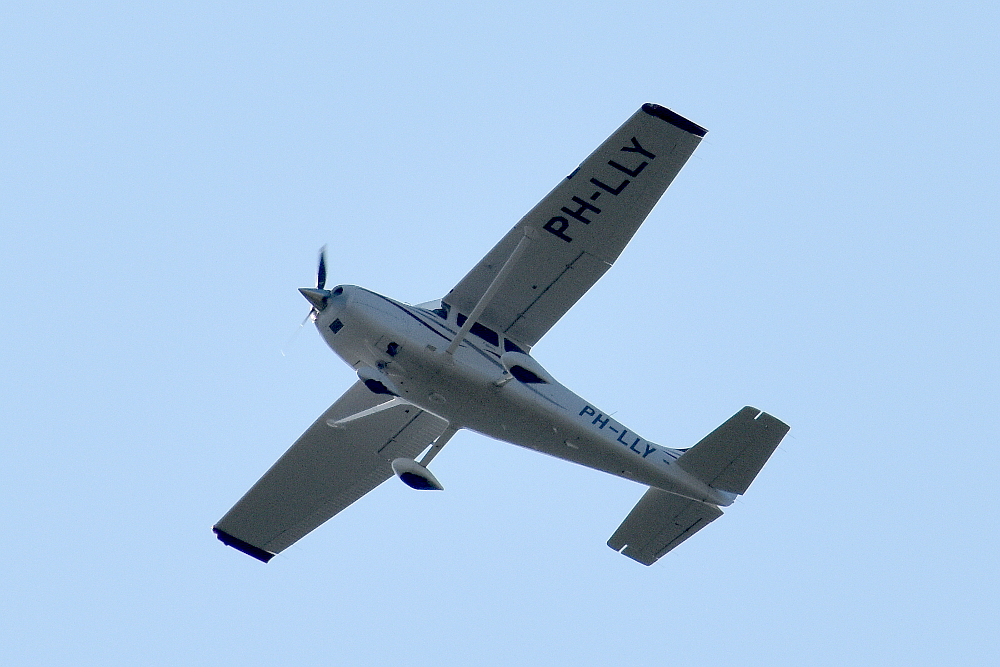

Cessna T182T Skylane, registration PH-LLY, built 2008, serial number T182-08871
Nijmegen, Netherlands, 17 April 2020
150 | 172 |
182 | 206 |
208 | 210 |
310 |
318 |
336/337 Skymaster | O-2 |
340 |
402 | 421
Citation |
500/501 | 510 |
525 | 525A |
525B | 525C |
550 |
560 | 560XL |
650 | 680 |
680A | 750
Cessna 206: U206 Super Skywagon, T206H Stationair
The six-seat Cessna 206 was introduced as a 1964 model. However, the original 1964 model was the U206, the "U" indicating "utility": this model was equipped with a pilot side door and large clamshell rear door serving the back two rows of seats, allowing easy loading of oversized cargo. From 1964 to 1969 the U206 was known as the "Super Skywagon". From 1970 it was named the "Stationair", a contraction of "Station Wagon of the Air".
After a production hiatus of twelve years, Cessna started manufacturing a new version of the venerable 206 in 1998, with the introduction of the newly certified 206H, marketed under the name "Stationair". The 206H is powered by a Lycoming IO-540-AC1A powerplant producing 300 hp (220 kW). The turbocharged T206H is powered by a Lycoming TSIO-540-AJ1A engine of 310 hp (230 kW).
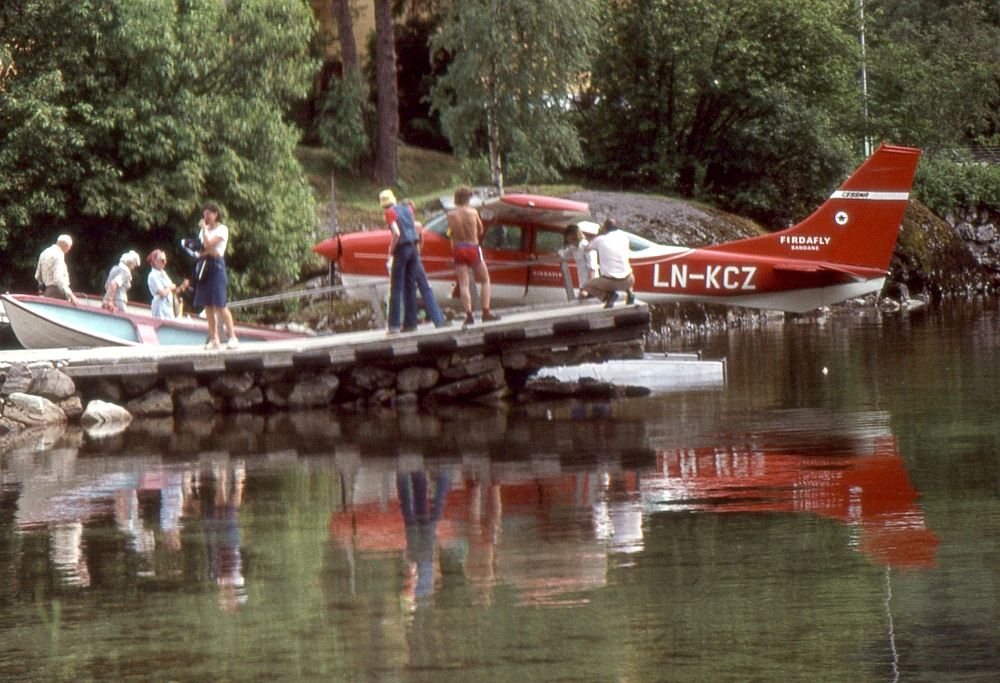
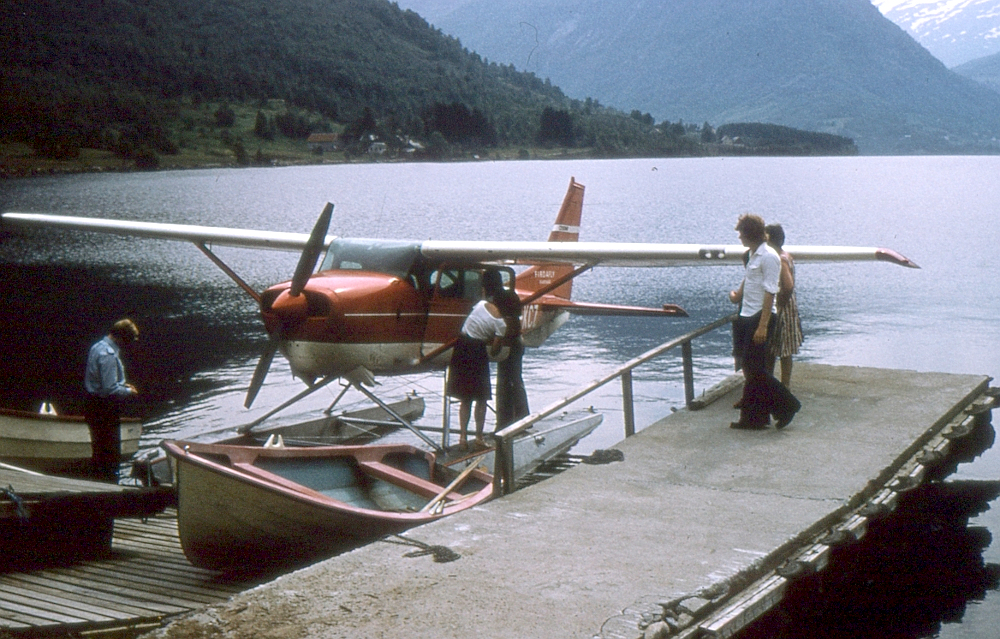
Cessna U206D Super Skywagon, registration LN-KCZ, built 1969, serial number U206D-1270
Skei, Norway, 18 June 1977
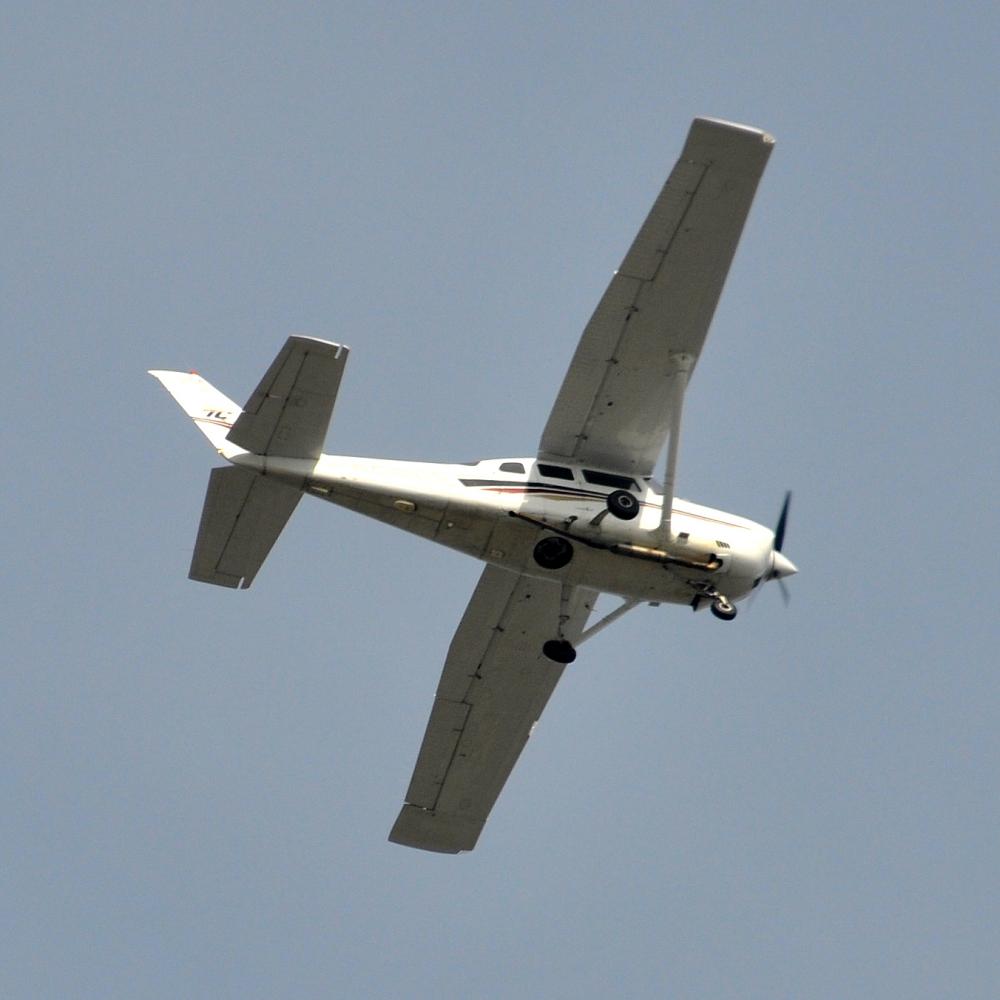
Cessna T206H Stationair, registration N989DE, built 2000, serial number T206-8001
Eindhoven Airport (EHEH/EIN), Eindhoven, Netherlands, 13 March 2017
150 | 172 |
182 | 206 |
208 | 210 |
310 |
318 |
336/337 Skymaster | O-2 |
340 |
402 | 421
Citation |
500/501 | 510 |
525 | 525A |
525B | 525C |
550 |
560 | 560XL |
650 | 680 |
680A | 750
Cessna 208 Caravan
The Cessna 208 Caravan is a single-engined turboprop, fixed-tricycle landing gear, short-haul regional airliner and utility aircraft. The airplane typically seats nine passengers with a single pilot, although with a FAR Part 23 waiver it can seat up to fourteen passengers. The aircraft is also used for cargo feederliner operations. It has a fixed tricycle landing gear but can also be fitted with floats or skis.
Variant 208B Caravan is marketed as 208B Grand caravan. It is 4 ft (1.2 m) longer than the 208; extending the cabin by the same amount.
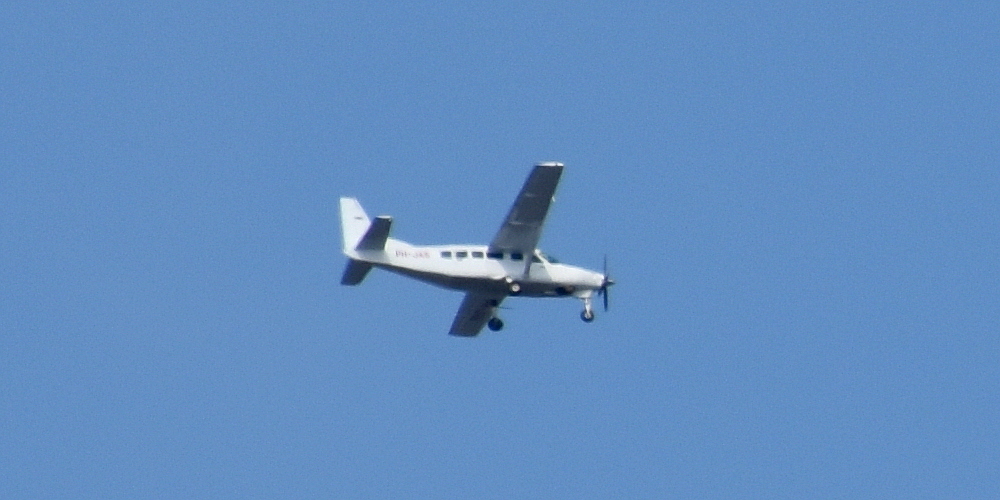
Cessna 208 Caravan, registration PH-JAS, built 1993, serial number 2080-0226
Nijmegen, Netherlands, 21 June 2019

Cessna 208B Grand Caravan, registration VN-B468, built 2014, serial number 208B-5121
Halong Bay, Vietnam, 25 November 2014
150 | 172 |
182 | 206 |
208 | 210 |
310 |
318 |
336/337 Skymaster | O-2 |
340 |
402 | 421
Citation |
500/501 | 510 |
525 | 525A |
525B | 525C |
550 |
560 | 560XL |
650 | 680 |
680A | 750
Cessna 210 Centurion
The Cessna 210 Centurion is a six-seat, high-performance, retractable-gear, single-engine, high-wing general aviation aircraft which was first flown in January 1957 and produced by Cessna until 1985.
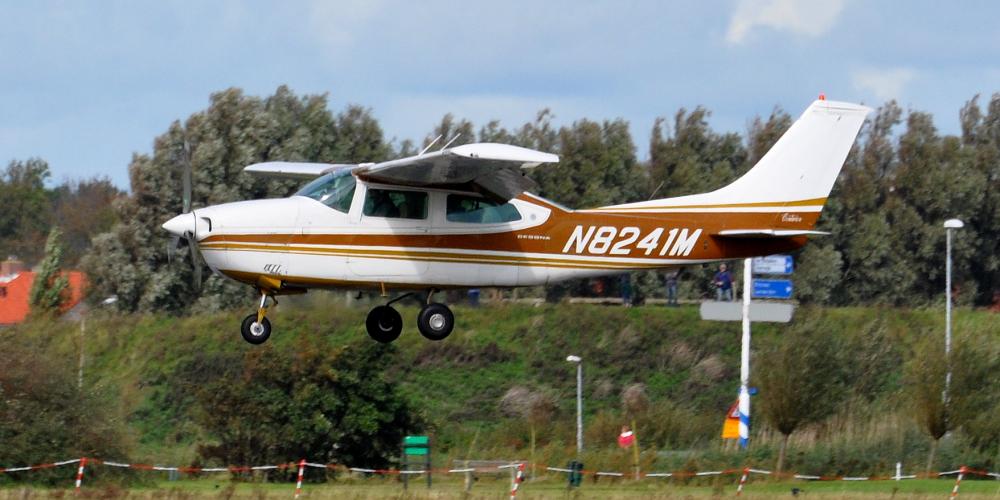
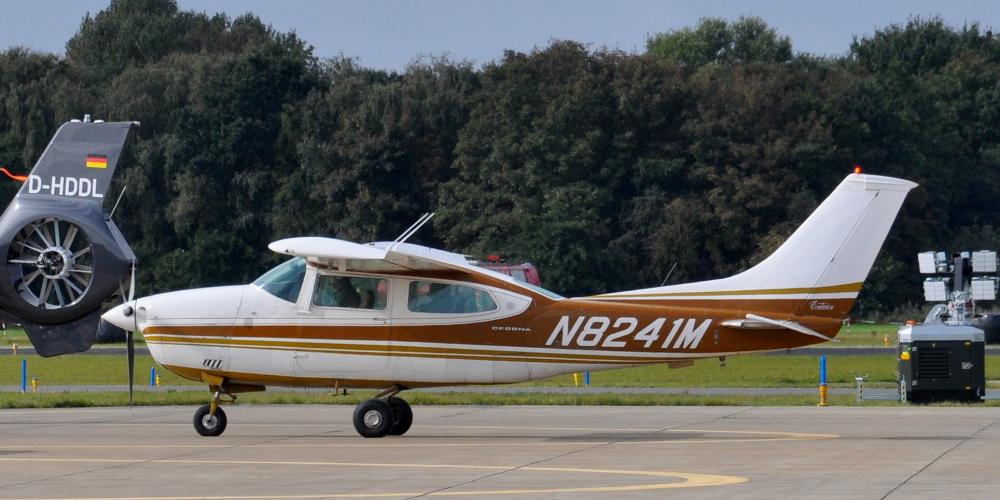

Cessna 210K Centurion, registration N8241M, built 1969, serial number 21059241
Den Helder Airport (Maritiem Vliegkamp De Kooy) (DHR/EHKD), Den Helder, 16 September 2017
150 | 172 |
182 | 206 |
208 | 210 |
310 |
318 |
336/337 Skymaster | O-2 |
340 |
402 | 421
Citation |
500/501 | 510 |
525 | 525A |
525B | 525C |
550 |
560 | 560XL |
650 | 680 |
680A | 750
Cessna 310
The Cessna 310 is a six-seat, low-wing, twin-engined monoplane that was produced by Cessna between 1954 and 1980. It was the first twin-engined aircraft that Cessna put into production after World War II.
The T310 is a version of the 310 with turbocharged Continental TSIO-520-B or TSIO-520-BB engines to increase the maximum takeoff weight.

Cessna 310F, registration HB-LBM, built 1961, serial number 310-0147
Cointrin (GVA), Geneva, Switzerland, 4 July 2015

Cessna T310R, registration OO-MSN, built 1976, serial number 310R-0562
Nijmegen, Netherlands, 18 April 2016
150 | 172 |
182 | 206 |
208 | 210 |
310 |
318 |
336/337 Skymaster | O-2 |
340 |
402 | 421
Citation |
500/501 | 510 |
525 | 525A |
525B | 525C |
550 |
560 | 560XL |
650 | 680 |
680A | 750
Cessna Model 318: T-37 Tweet
The Cessna T-37 Tweet (designated Model 318 by Cessna) is a small, economical twin-engined jet trainer type which flew for decades as a primary trainer for the United States Air Force (USAF) and in the air forces of several other nations.
The Cessna A-37 Dragonfly variant, or Super Tweet, is a light attack aircraft developed from the T-37 basic trainer in the 1960s and 1970s by Cessna of Wichita, Kansas. The A-37 was introduced during the Vietnam War (A-37A in August 1967 and A-37B beginning of 1968) and remained in peacetime service afterward. A total of 577 A-37Bs was built.
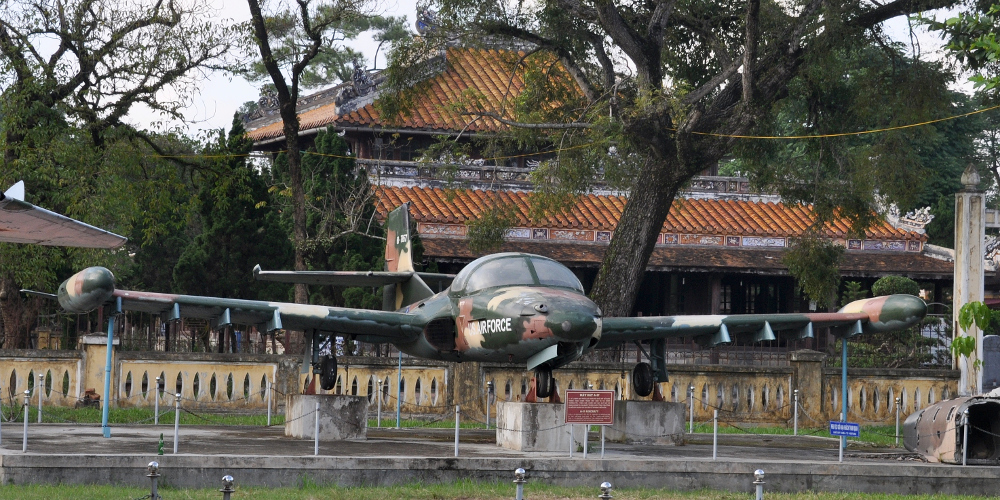
Cessna A-37B Dragonfly, registration 68-7957, built ????, serial number 43104
General Museum Complex, Hue, Vietnam, 28 November 2014
150 | 172 |
182 | 206 |
208 | 210 |
310 |
318 |
336/337 Skymaster | O-2 |
340 |
402 | 421
Citation |
500/501 | 510 |
525 | 525A |
525B | 525C |
550 |
560 | 560XL |
650 | 680 |
680A | 750
Cessna 336/337 Skymaster
The Cessna Skymaster is a United States twin-engine civil utility aircraft built in a push-pull configuration. Its engines are mounted in the nose and rear of its pod-style fuselage. Twin booms extend aft of the wings to the vertical stabilizers, with the rear engine between them. The horizontal stabilizer is aft of the pusher propeller, mounted between and connecting the two booms. The combined tractor and pusher engines produce centerline thrust and a unique sound.
The first Skymaster, Model 336 Skymaster, had fixed landing gear and initially flew on February 28, 1961. It went into production in May 1963 with 195 being produced through mid-1964.
In February 1965, Cessna introduced the Model 337 Super Skymaster. The model was larger, and had more powerful engines, retractable landing gear, and a dorsal air scoop for the rear engine. (The "Super" prefix was subsequently dropped from the name.) In 1966, the turbocharged T337 was introduced, and in 1973, the pressurized P337G entered production. The Cessna O-2 Skymaster is a military version of the Cessna 337 Super Skymaster.
Cessna built 2993 Skymasters of all variants, including 513 military O-2 versions. Production in America ended in 1982, but was continued by Reims in France, with the FTB337 STOL and the military FTMA Milirole.
150 | 172 |
182 | 206 |
208 | 210 |
310 |
318 |
336/337 Skymaster | O-2 |
340 |
402 | 421
Citation |
500/501 | 510 |
525 | 525A |
525B | 525C |
550 |
560 | 560XL |
650 | 680 |
680A | 750
Cessna O-2 Skymaster
The Cessna O-2 Skymaster (nicknamed "Oscar Deuce") is a military version of the Cessna 337 Super Skymaster, used for forward air control (FAC) and psychological operations (PSYOPS) by the US military between 1967 and 2010.
In 1966 the United States Air Force (USAF) commissioned Cessna to build a military variant of the Skymaster to replace the O-1 Bird Dog and the O-2.
As with the civilian version, the Skymaster was a low-cost twin-engine piston-powered aircraft, with one engine in the nose of the aircraft and a second engine in the rear of the fuselage. The push-pull configuration meant a simpler single-engine operating procedure due to centerline thrust compared to the common low-wing mounting of most twin engine light planes, and also allowed for a high wing, providing clear observation below and behind the aircraft.
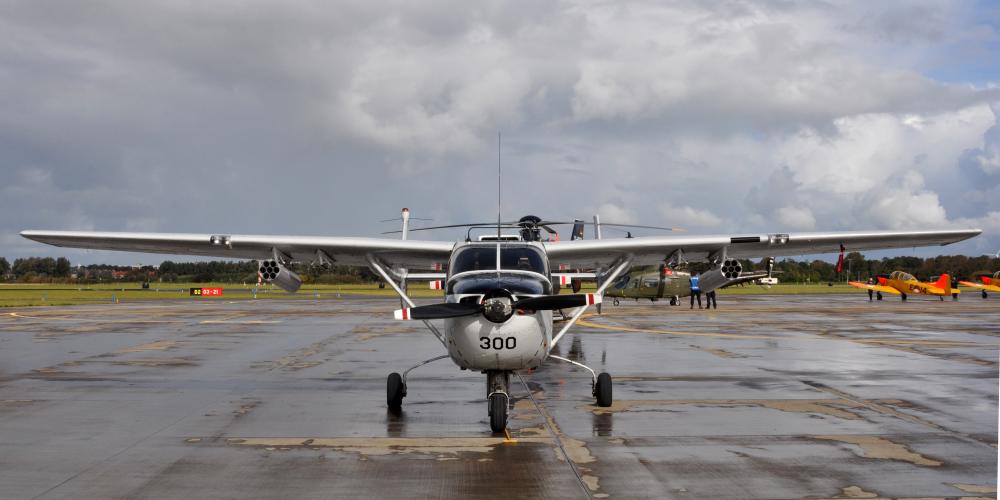
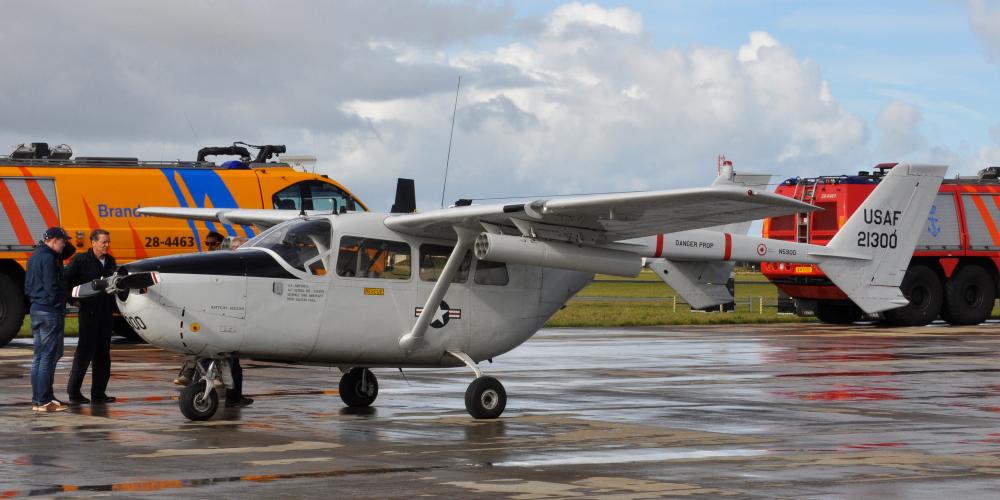
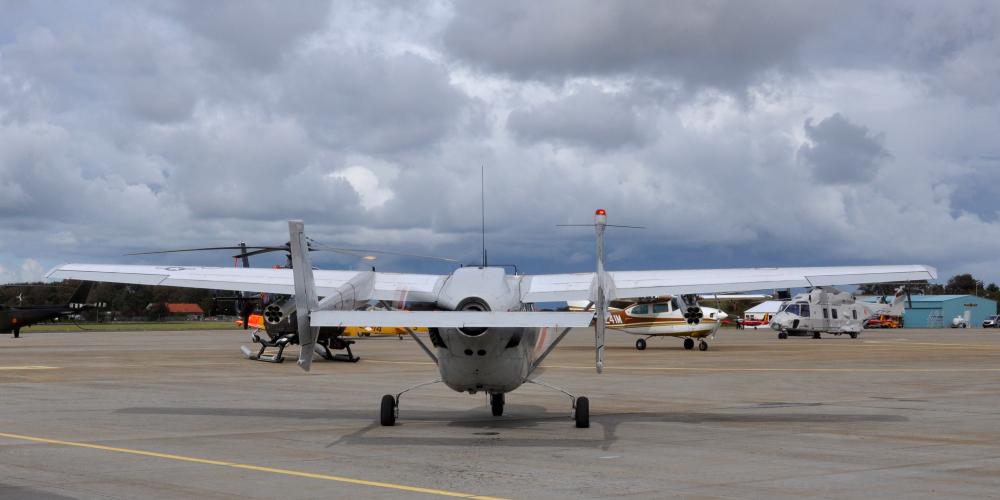
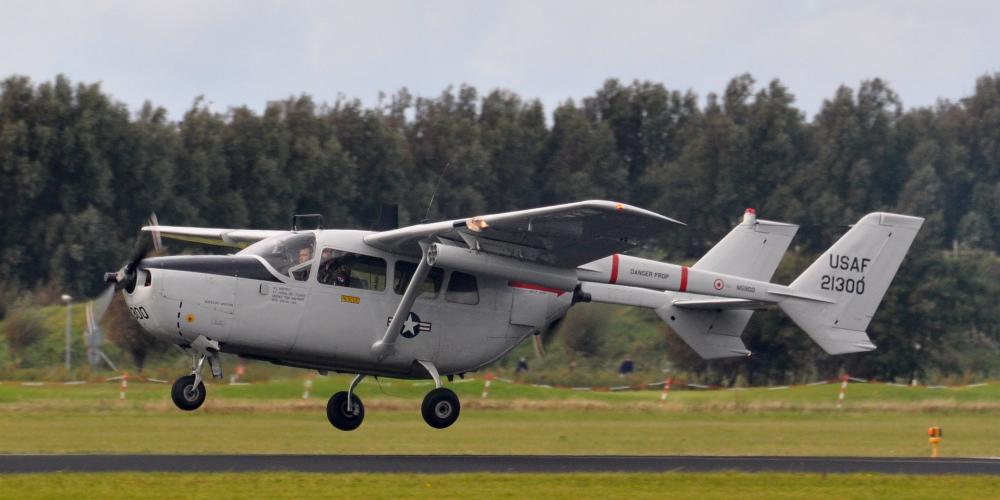
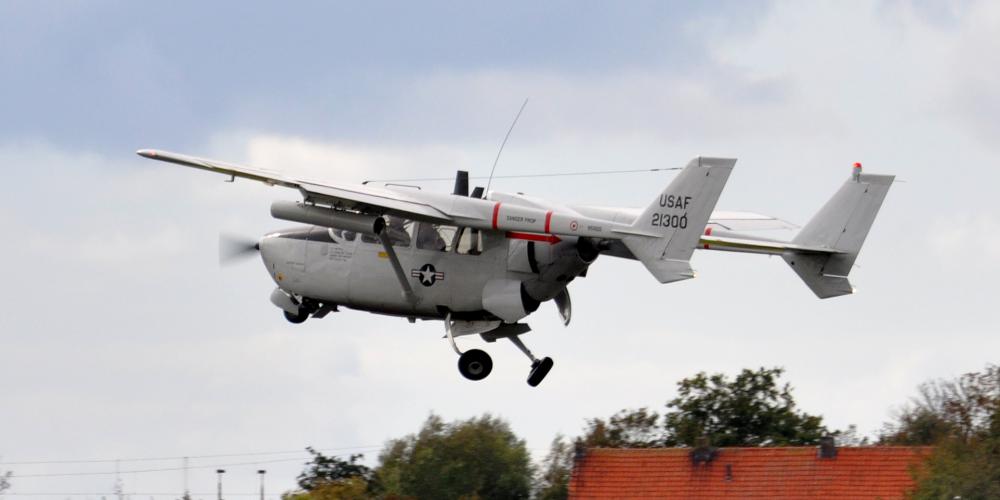
Cessna O-2A Super Skymaster, registration N590D, built 1967, serial number 337M-0006
Den Helder Airport (Maritiem Vliegkamp De Kooy) (DHR/EHKD), Netherlands, 16 September 2017
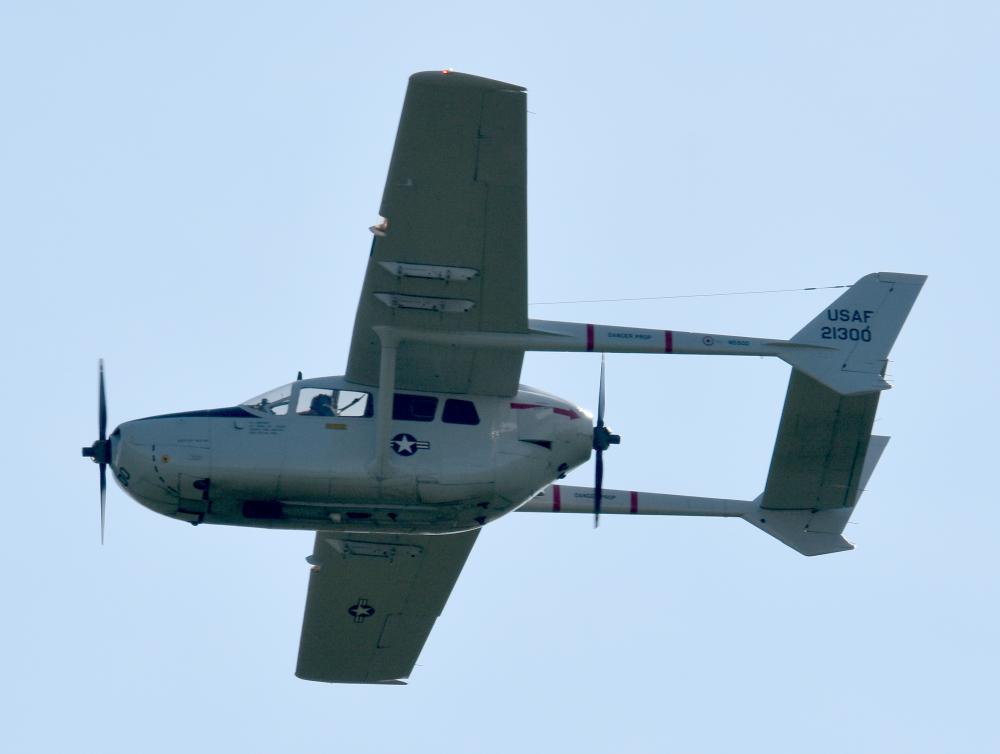

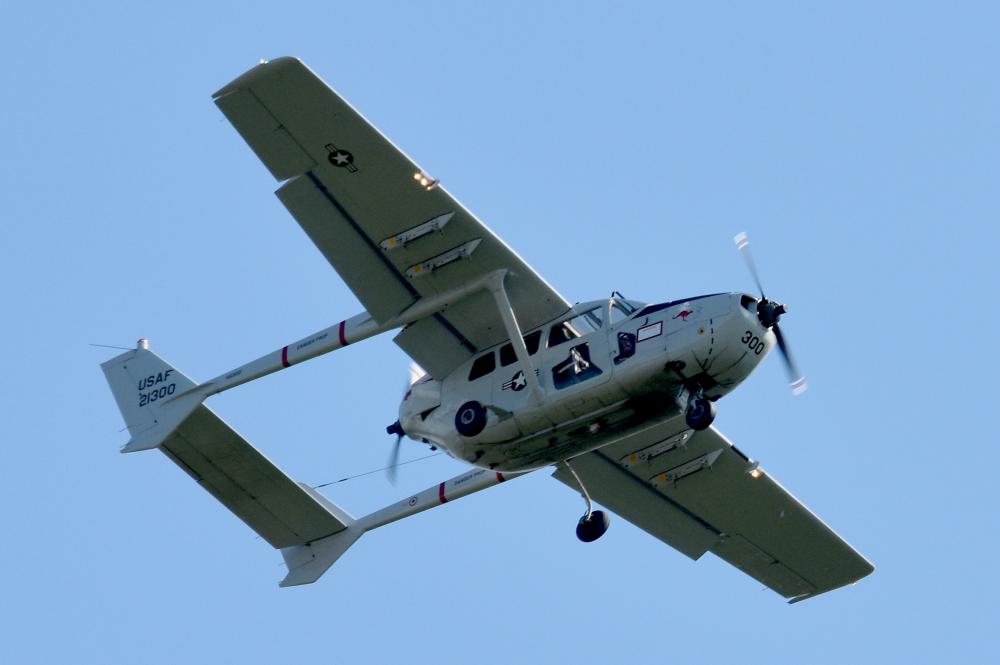

Cessna O-2A Super Skymaster, registration N590D, built 1967, serial number 337M-0006
Ede, Netherlands, 24 August 2019
150 | 172 |
182 | 206 |
208 | 210 |
310 |
318 |
336/337 Skymaster | O-2 |
340 |
402 | 421
Citation |
500/501 | 510 |
525 | 525A |
525B | 525C |
550 |
560 | 560XL |
650 | 680 |
680A | 750
Cessna 340
The Cessna 340 is a twin piston engine pressurized business aircraft that was manufactured by Cessna. The Cessna 335 is an unpressurized version, which appears the same externally as the 340. It sold in fewer numbers than the 340.
The 340 was a cabin-class development of the successful Cessna 310. It is a six-seat aircraft, with four passenger seats, an aisle and an airstair door. The tail and landing gear were based on the Cessna 310's units, while its wings were from the Cessna 414. The 340's primary selling feature was its spacious, pressurized cabin, the first in a light twin.
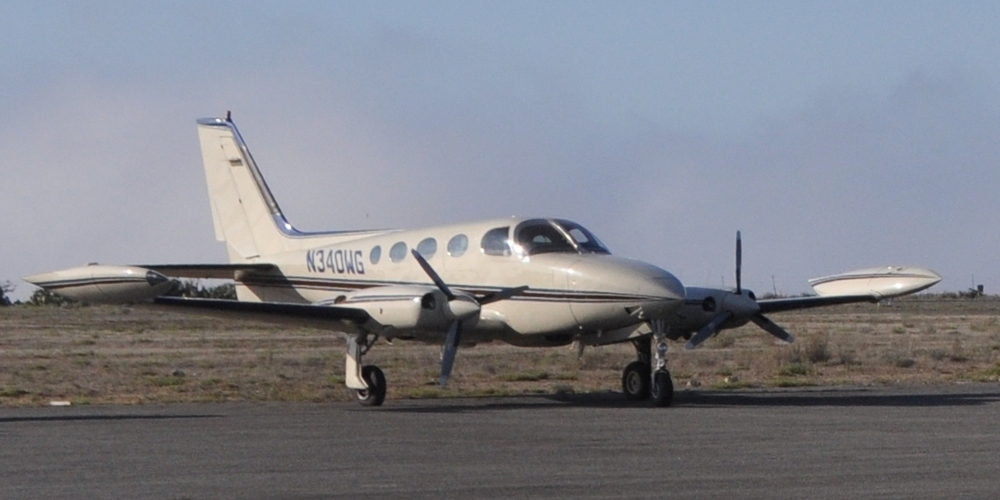
Cessna 340, registration N340WG, built 1972, serial number 310-0147
Catalina Airport (CIB), Santa Catalina Island, CA, USA, 31 July 2010
150 | 172 |
182 | 206 |
208 | 210 |
310 |
318 |
336/337 Skymaster | O-2 |
340 |
402 | 421
Citation |
500/501 | 510 |
525 | 525A |
525B | 525C |
550 |
560 | 560XL |
650 | 680 |
680A | 750
Cessna 401/402
The Cessna 401 and 402 are series of 6 to 10 seat, light twin, piston engine aircraft. This line was manufactured by Cessna from 1966 to 1985 under the name Utiliner and Businessliner. All seats are easily removable so that the aircraft can be used in an all-cargo configuration. Neither the Cessna 401 nor the 402 were pressurized, nor were they particularly fast for the installed horsepower. Instead, Cessna intended them to be inexpensive to purchase and operate.
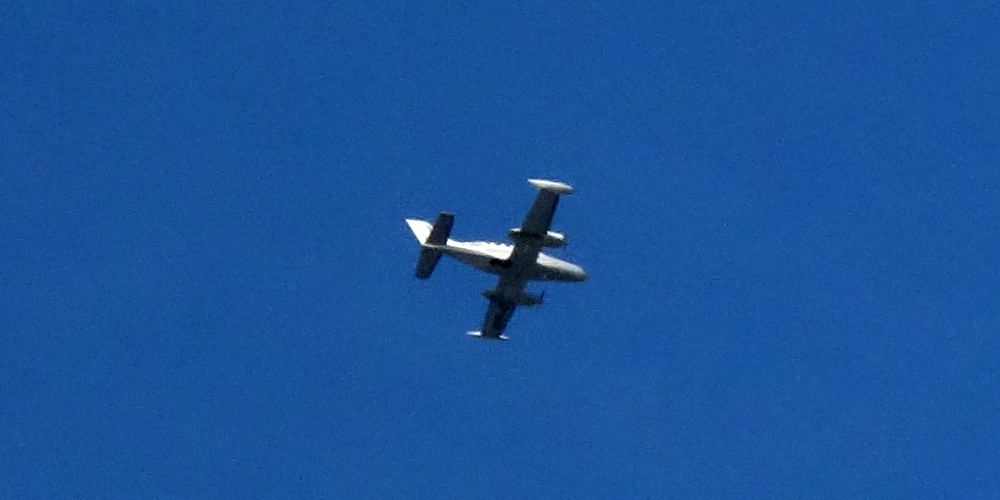
Cessna 402B Businessliner, registration D-IBWF, built ????, serial number 402B-0221
Nijmegen, Netherlands, 15 March 2017
150 | 172 |
182 | 206 |
208 | 210 |
310 |
318 |
336/337 Skymaster | O-2 |
340 |
402 | 421
Citation |
500/501 | 510 |
525 | 525A |
525B | 525C |
550 |
560 | 560XL |
650 | 680 |
680A | 750
Cessna 421 Golden Eagle
The Cessna 421 Golden Eagle is a six or seven seat twin-engined light transport aircraft, developed in the 1960s by Cessna as a pressurized version of the earlier Cessna 411. It is the largest and fastest of Cessna's twin engine piston line.
The Cessna 421 was first produced in May 1967. It had "Stabila-Tip" fuel tanks on the wingtips (like the Cessna 310) and electro-mechanical landing gear similar to that of the 310. It was an immediate hit, selling 200 planes in its first year.
The very next year, 1969, the design was refined, with a three-inch stretch of the fuselage, five more gallons of fuel capacity, and a 40-pound increase in gross weight. The plane was redesignated the Cessna 421A.
In 1971 the design was again improved. Both empty and gross weight increased and the wingspan was increased by two feet, raising the service ceiling by 5,000 feet. The nose was stretched two feet to accommodate a larger nose baggage section. This new plane is designated the Cessna 421B.
In 1976 the 421C appeared which featured wet wings, the absence of wingtip fuel tanks and landing gear that was changed from straight-leg to a trailing-link design from the 1981 model year onwards. Production ended in 1985 after 1,901 aircraft had been delivered.
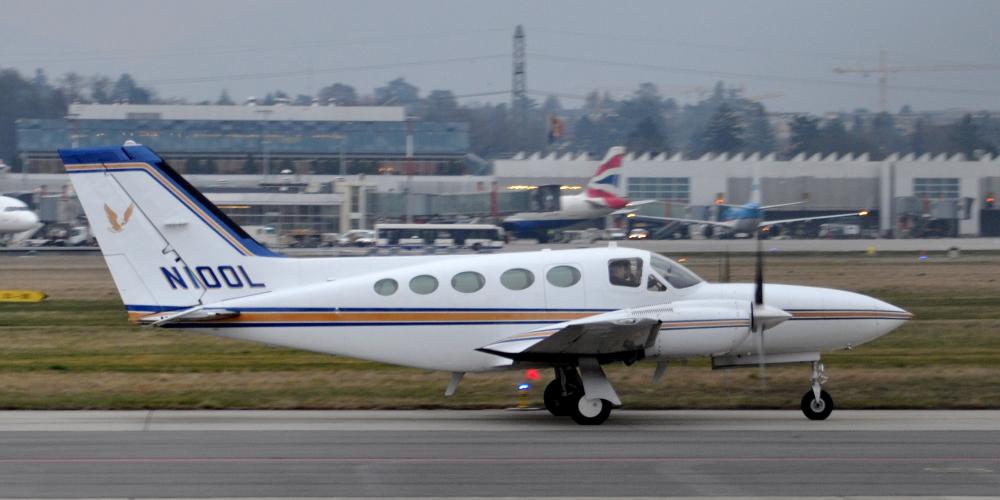
Cessna 421C Golden Eagle, registration N100L, built 1977, serial number 421C-0313
Cointrin (GVA), Geneva, Switzerland, 22 February 2018
150 | 172 |
182 | 206 |
208 | 210 |
310 |
318 |
336/337 Skymaster | O-2 |
340 |
402 | 421
Citation |
500/501 | 510 |
525 | 525A |
525B | 525C |
550 |
560 | 560XL |
650 | 680 |
680A | 750
Cessna Citation
The Cessna Citation family is Cessna's business jets line. The 7,000th Citation was delivered on June 27, 2016, forming the largest business jet fleet: the first Citation was put into service in 1972 and more than 35 million flight hours have been logged since.
It started with the small Citation (built 1971-1976), which was upgraded to the Citation I (Model 500/501, built 1976-1985), developed into the Citation II/Bravo (Model 550, 1978-2006), the Citation V/Ultra/Encore (Model 560, 1989-2011) and the CitationJet (Model 525, since 1993). The standup Citation III/VI/VII (Model 650) was delivered from 1983 to 2000, its fuselage was reused in the Citation X/X+ (Model 750) delivered from 1996 to 2018, the Excel (Model 560XL) since 1998 and the Sovereign (Model 680) since 2004. The Mustang (Model 510) was a Very Light Jet (VLJ) delivered from 2006 to 2017 while the flat floor fuselage Latitude (Model 680A) is delivered since 2015 and the larger Longitude from 2018.
150 | 172 |
182 | 206 |
208 | 210 |
310 |
318 |
336/337 Skymaster | O-2 |
340 |
402 | 421
Citation |
500/501 | 510 |
525 | 525A |
525B | 525C |
550 |
560 | 560XL |
650 | 680 |
680A | 750
Cessna 500/501 Citation I
The Cessna 500 Citation I, built from 1976 until 1985 by the Cessna Aircraft Company in Wichita, Kansas, is a small-sized business jet, the first turbofan powered. The Citation I is the basis for the early Cessna Citation family.
In 1968 plans were annunced for an eight-place business jet that, unlike its competition, would be suitable for operations from shorter airfields, essentially aiming to compete in the light-to-medium twin turboprop market, rather than the existing business jet market. It resulted in the first flight of a prototype, the Fanjet 500, on 15 September 1969. After a longer-than-expected development flight test program, with a number of changes to the design, the finished aircraft was debuted with the new name Citation (Model 500) and received its FAA certification in September 1971.
Turbofan rather than turbojets and straight wings rather than swept wings made it cruise slowly compared to other business jets and Learjet salesmen mocked it as the “Nearjet” vulnerable to “bird strikes from the rear” and nicknamed the “Citation” as “Slowtation”.
In 1976, several product improvements were added to the aircraft in response to market pressures, including a longer span wing, higher maximum gross weight and thrust reversers, which made shorter landing fields available to customers. With these improvements came the name Citation I. When production on the model 500 ended in 1985, 377 airframes had been built.
Like the Learjets, the Citation I required a crew of two. But since the Citation was intended to be marketed against twin turboprops, which can be flown by a single pilot, this restriction limited its intended market. Cessna's answer was the Model 501 Citation I/SP, with SP referring to its certified single-pilot capability. The aircraft was first delivered in early 1977, and a total of 312 aircraft were produced, and production also ended in 1985.
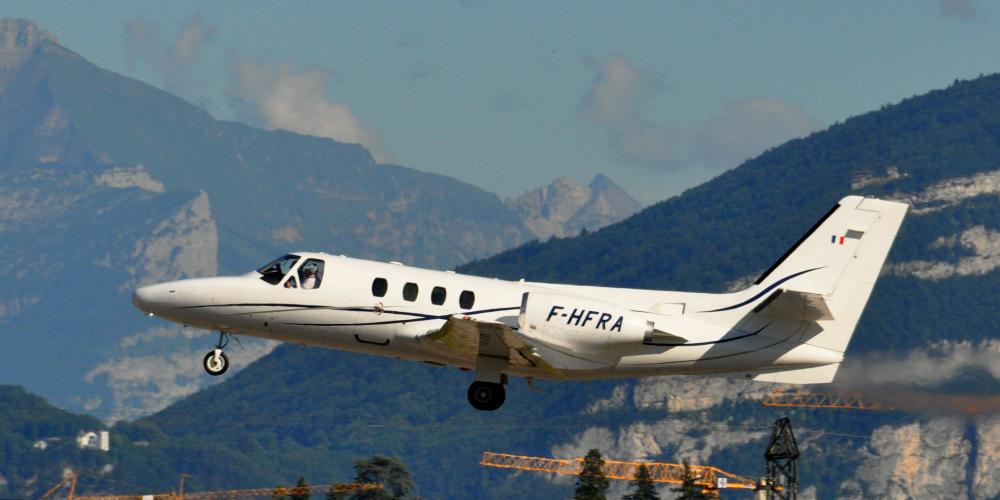
Cessna 501 Citation I/SP, registration F-HFRA, built 1978, serial number 501-0044-0313
Cointrin (GVA), Geneva, Switzerland, 4 July 2017
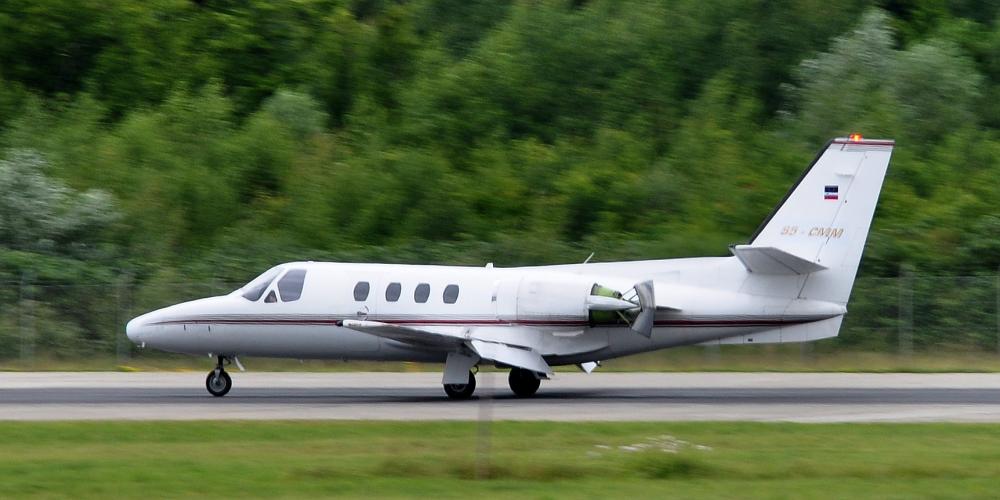
Cessna 501 Citation I/SP, registration S5-CMM, built 1983, serial number 501-0259
Cointrin (GVA), Geneva, Switzerland, 1 July 2017
150 | 172 |
182 | 206 |
208 | 210 |
310 |
318 |
336/337 Skymaster | O-2 |
340 |
402 | 421
Citation |
500/501 | 510 |
525 | 525A |
525B | 525C |
550 |
560 | 560XL |
650 | 680 |
680A | 750
Cessna 510 Citation Mustang
The Cessna Citation Mustang, Model 510, is a very light jet (VLJ), class business jet, built by Cessna Aircraft Company at their Independence, Kansas production facility. The Mustang, in standard configuration, has four passenger seats in the aft cabin, a toilet, and seating for two in the cockpit. Like most other light jets, the Mustang is approved for single-pilot operation.
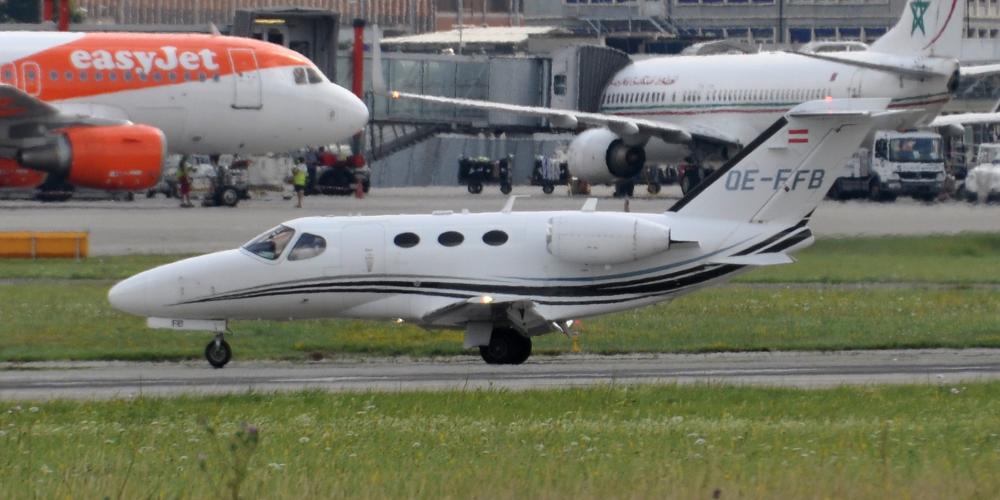
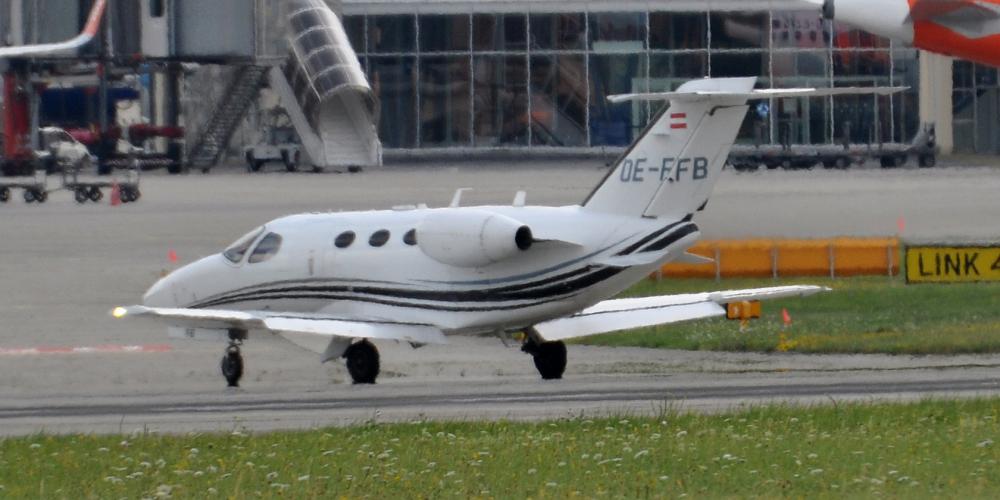
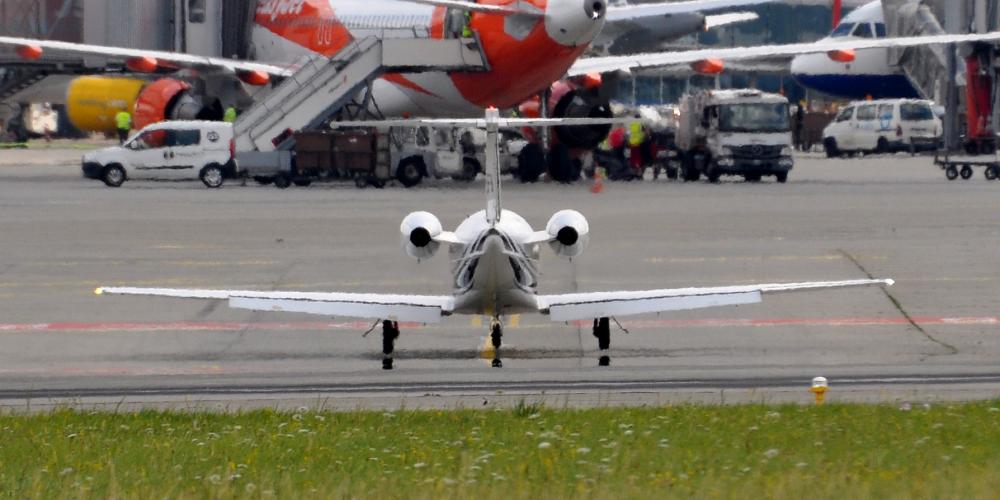
Cessna 510 Citation Mustang, registration OE-FFB, built 2008, serial number 510-0065
Cointrin (GVA), Geneva, Switzerland, 6 July 2016
150 | 172 |
182 | 206 |
208 | 210 |
310 |
318 |
336/337 Skymaster | O-2 |
340 |
402 | 421
Citation |
500/501 | 510 |
525 | 525A |
525B | 525C |
550 |
560 | 560XL |
650 | 680 |
680A | 750
Cessna 525 CitationJet CJ1/CJ1+/M2
The Cessna CitationJet series (Model 525) are light business jets built in Wichita, Kansas. Variants are marketed under the CJ, CJ1 and CJ1+ names.
Model 525 serial numbers 0001 to 0359, powered by Williams FJ-44-1A turbofans, are marketed as the CitationJet. Being launched in 1989, it was developed as a replacement for the Cessna Citation I. The CitationJet's first flight was on April 29, 1991, with its first delivery on March 30, 1993.
Model 525 serial numbers 0360 to 0599 are marketed as the CitationJet CJ1 and are powered by the same Williams FJ-44-1A. It was improved with a more-modern EFIS avionics suite and a moderate increase in maximum takeoff weight.
Model 525 serial number 0600 and higher are marketed as CitationJet CJ1+ and are powered by Williams FJ-44-1AP turbofans. With the same airframe, it has an updated avionics package and FADEC engine control.
Model 525 marketed as Cessna Citation M2 are powered by improved FJ44-1AP-21 turbofans and are equipped with modern Garmin G3000 avionics replacing Rockwell Collins Pro Line 21. Launched in September 2011, it is based on the then out-of-production CJ1 variant and features a new cabin layout and a more efficient FJ44 version. The initial M2 prototype first flew on 9 March 2012. With 150 produced since introduction in 2013, it became Cessna's entry-level jet after the Citation Mustang production stopped in May 2017. The 250th M2 was delivered on June 15, 2020.

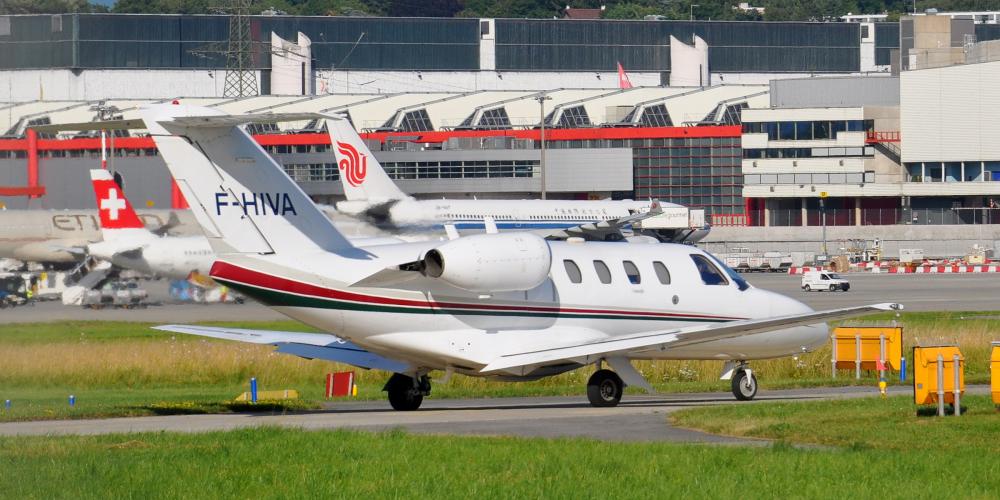
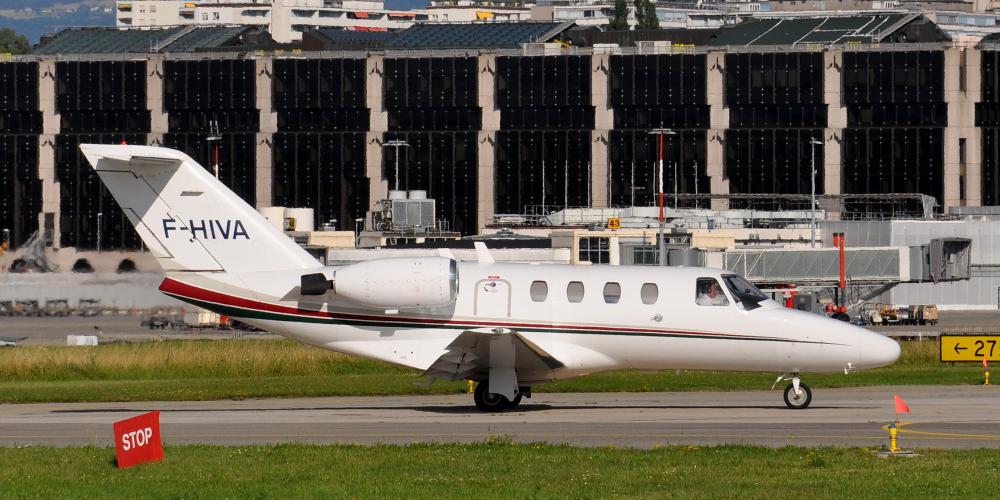
Cessna 525 CitationJet, registration F-HIVA, built 1998, serial number 525-0235
Cointrin (GVA), Geneva, Switzerland, 7 July 2016
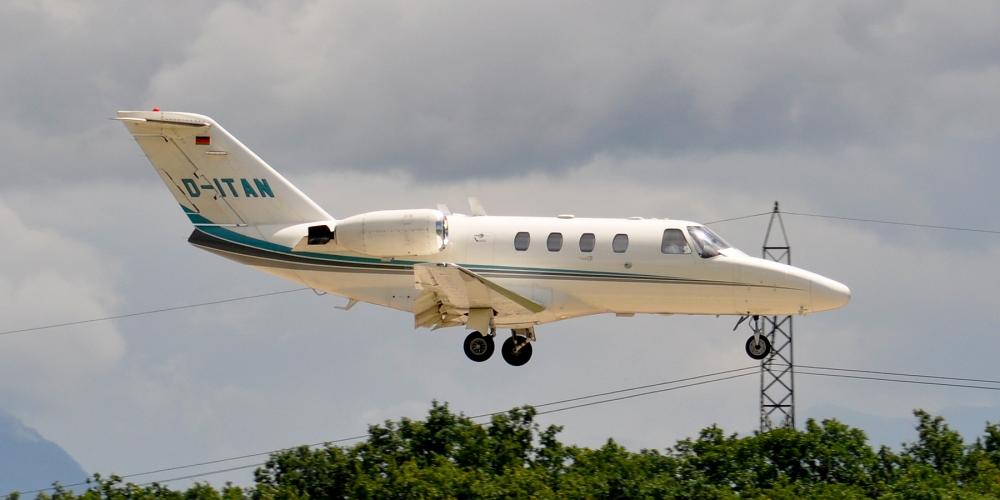
Cessna 525 CitationJet CJ1, registration D-ITAN, built 2000, serial number 525-0399
Cointrin (GVA), Geneva, Switzerland, 13 July 2016
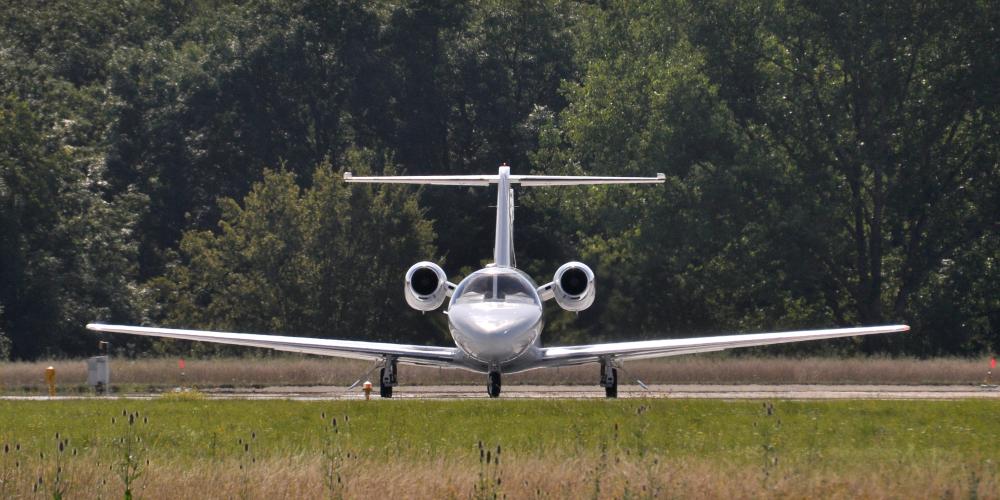
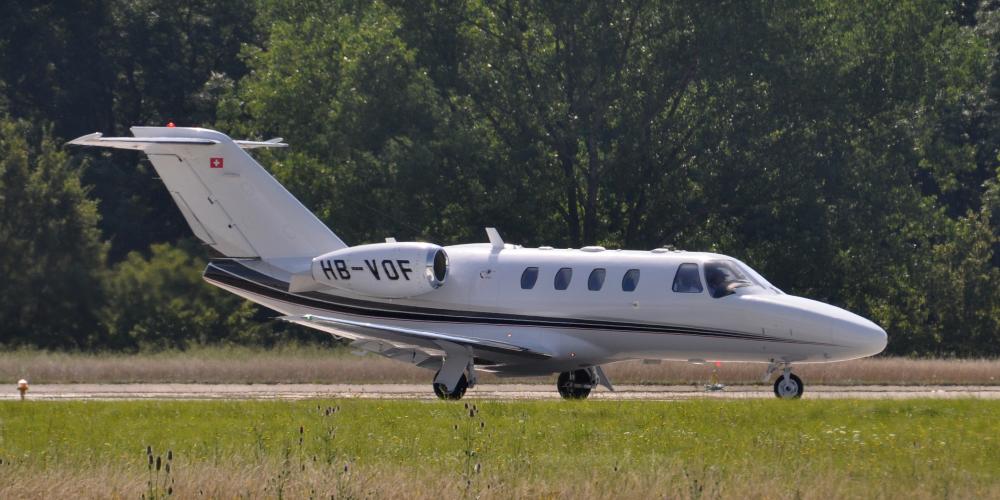

Cessna 525 CitationJet CJ1+, registration HB-VOF, built 2006, serial number 525-0623
Cointrin (GVA), Geneva, Switzerland, 28 July 2016
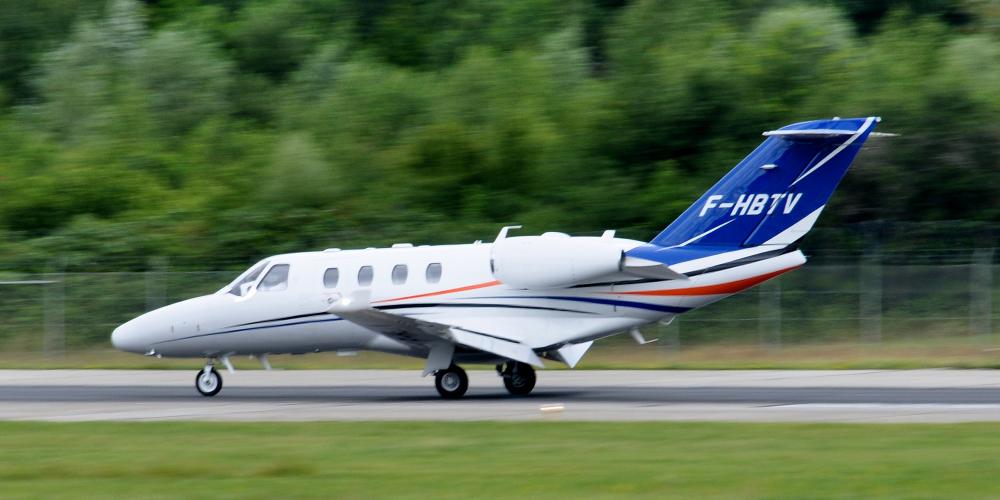
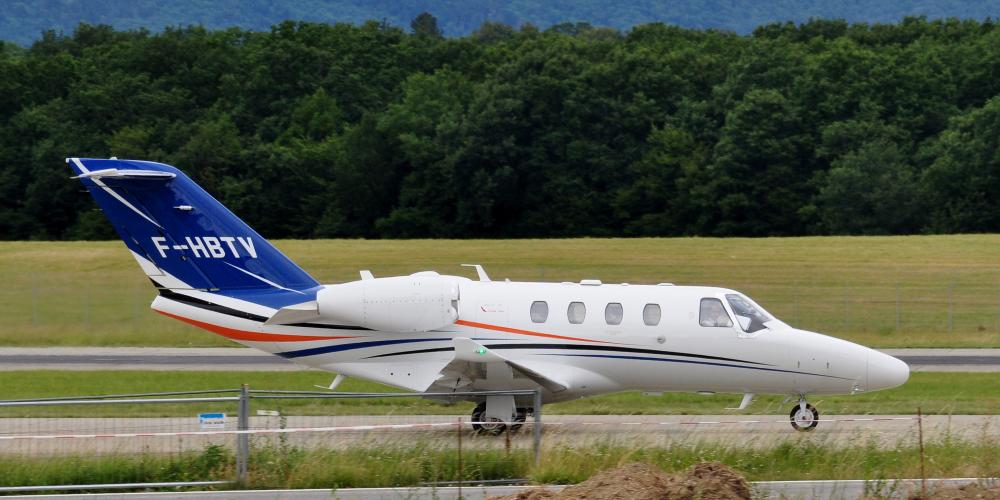
Textron Aviation 525 CitationJet M2, registration F-HBTV, built 2016, serial number 525-0918
Cointrin (GVA), Geneva, Switzerland, 1 July 2017
150 | 172 |
182 | 206 |
208 | 210 |
310 |
318 |
336/337 Skymaster | O-2 |
340 |
402 | 421
Citation |
500/501 | 510 |
525 | 525A |
525B | 525C |
550 |
560 | 560XL |
650 | 680 |
680A | 750
Cessna 525A CitationJet CJ2/CJ2+
Model 525A serial numbers 0001 to 0299, marketed as the CitationJet CJ2 is a 5-foot stretch of the CJ1 (Model 525) powered by Williams FJ44-2C turbofans and first delivered in 2000.
Model 525A serial numbers 0300 and higher, marketed as the CitationJet CJ2+ and first delivered in April 2006, offer increased performance with updated avionics and Williams FJ44-3A-24 turbofans with FADEC control.

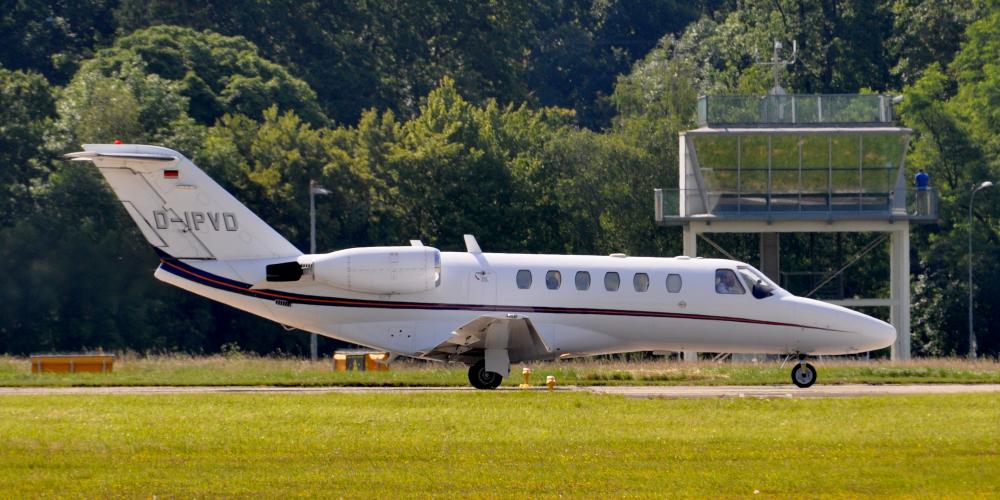
Cessna 525A CitationJet CJ2, registration D-IPVD, built 2004, serial number 525A-0218
Cointrin (GVA), Geneva, Switzerland, 8 July 2016
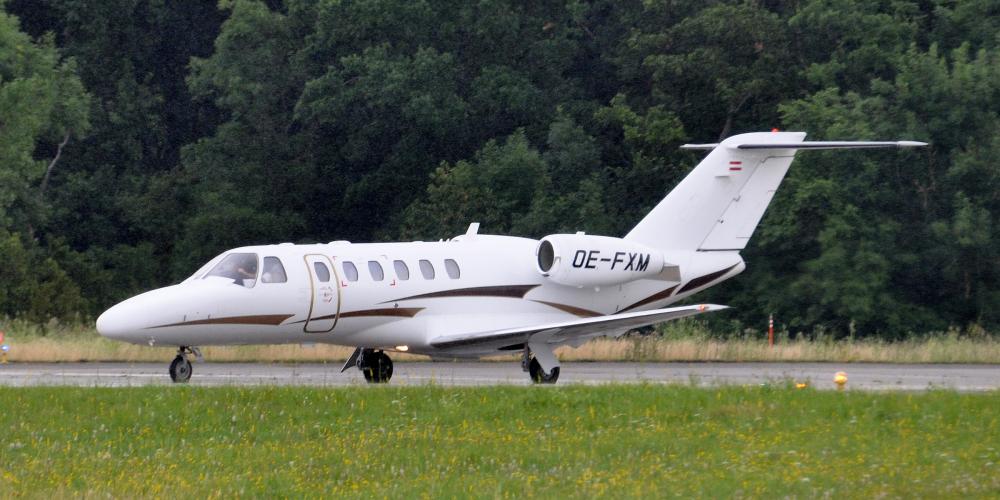
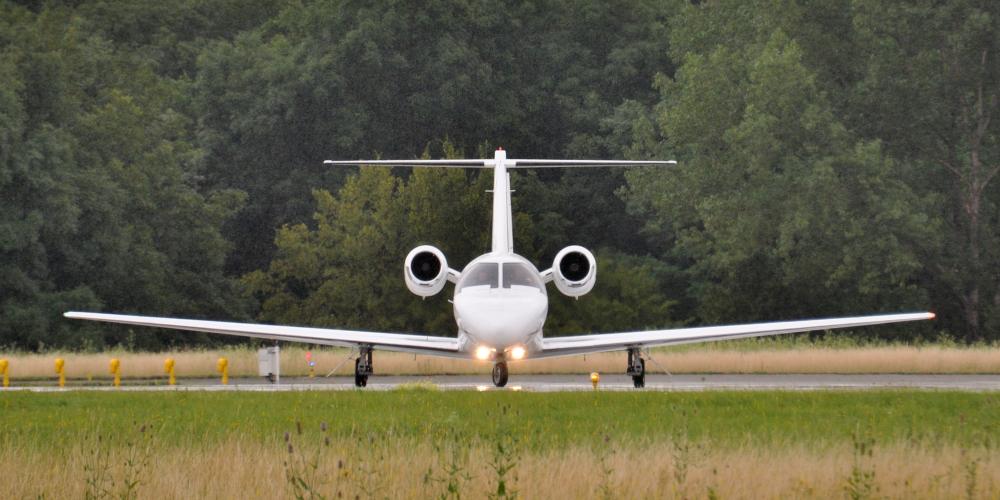

Cessna 525A CitationJet CJ2+, registration OE-FXM, built 2007, serial number 525A-0341
Cointrin (GVA), Geneva, Switzerland, 22 July 2016
150 | 172 |
182 | 206 |
208 | 210 |
310 |
318 |
336/337 Skymaster | O-2 |
340 |
402 | 421
Citation |
500/501 | 510 |
525 | 525A |
525B | 525C |
550 |
560 | 560XL |
650 | 680 |
680A | 750
Cessna 525B CitationJet CJ3
Model 525B, marketed as the CitationJet CJ3, are a further stretch of the CJ2 powered by Williams FJ-44-3A turbofans. Unveiled at the September 2002 National Business Aviation Association convention, it first flew on April 17, 2003, was FAA certified in October 2004 and deliveries began in December of that year. The cockpit with Rockwell Collins avionics is designed for single-pilot operation but can accommodate two crew members. Its customizable cabin typically has six club seats in a center-style configuration with an accessible in flight baggage compartment and external baggage access.
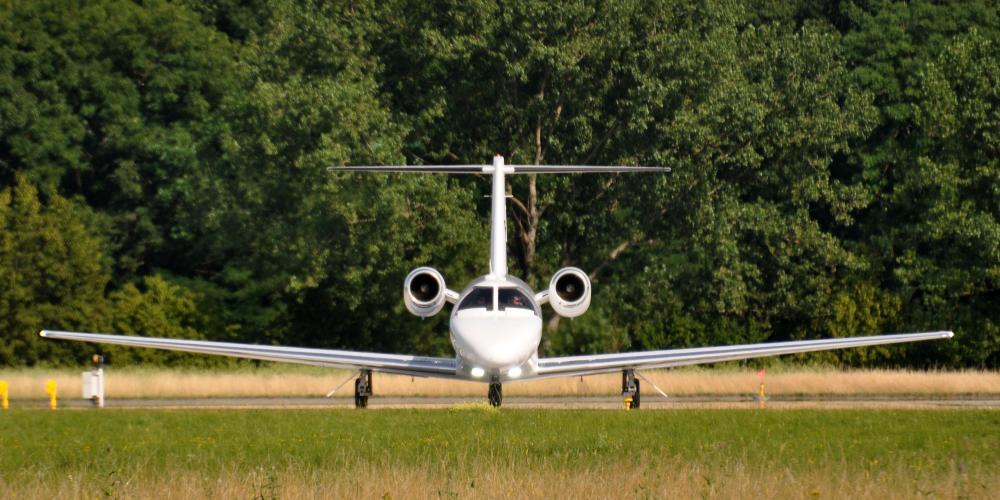

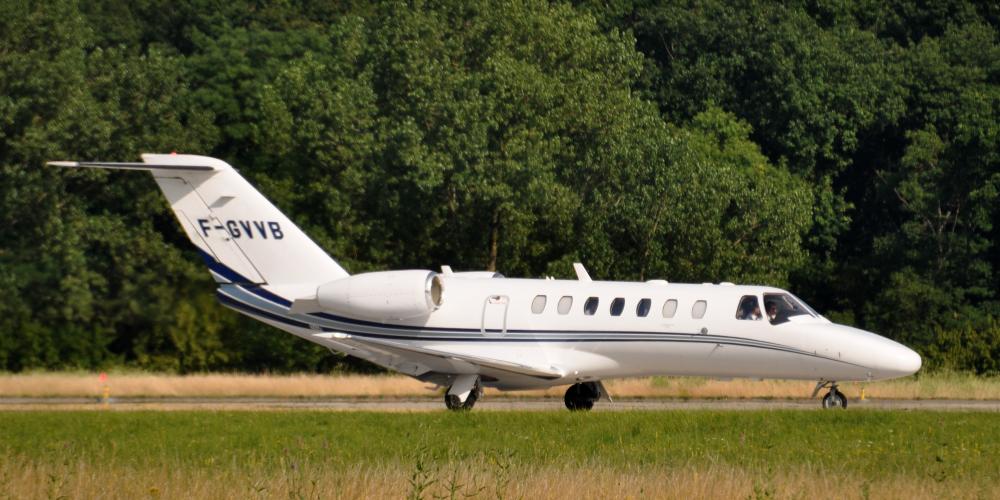
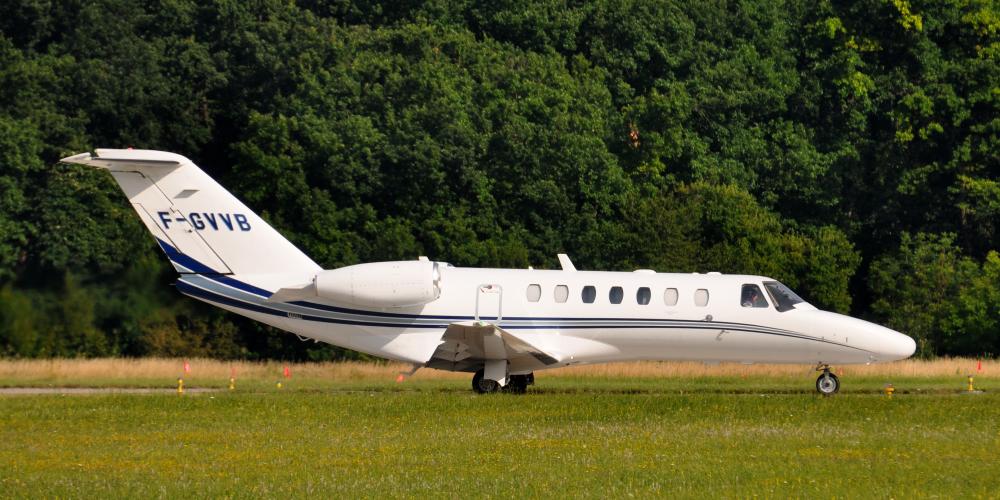
Cessna 525B CitationJet CJ3, registration F-GVVB, built 2009, serial number 525B-0300
Cointrin (GVA), Geneva, Switzerland, 20 July 2016
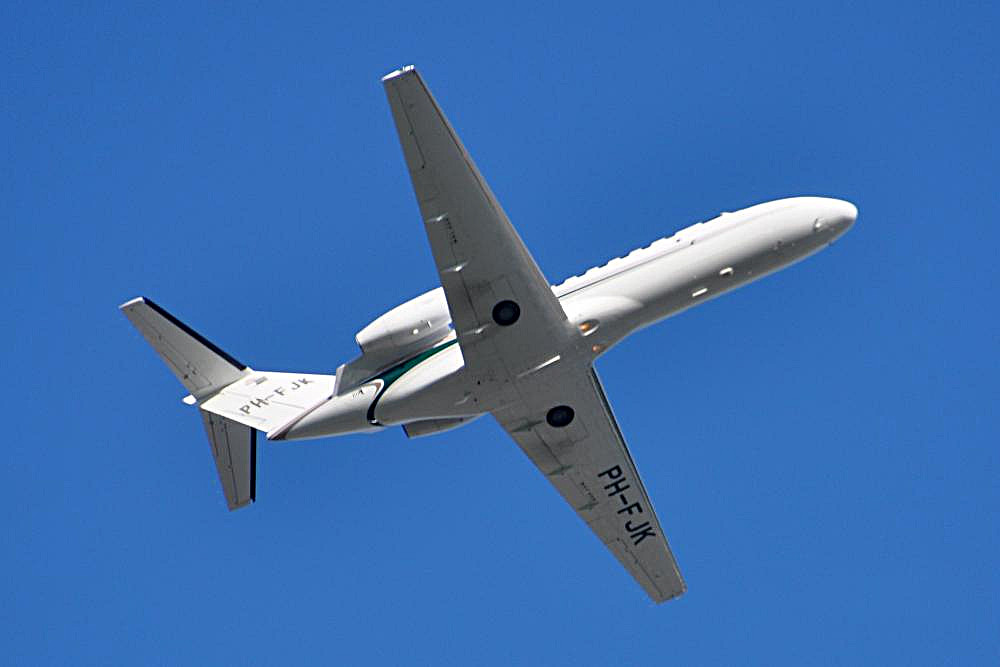
Cessna 525B CitationJet CJ3, registration PH-FJK, built 2008, serial number 525B-0291
Cointrin (GVA), Geneva, Switzerland, 3 May 2017
150 | 172 |
182 | 206 |
208 | 210 |
310 |
318 |
336/337 Skymaster | O-2 |
340 |
402 | 421
Citation |
500/501 | 510 |
525 | 525A |
525B | 525C |
550 |
560 | 560XL |
650 | 680 |
680A | 750
Cessna 525C CitationJet CJ4
Its wing design comes from the moderately swept wing of the Citation Sovereign (680). Powered by Williams FJ44-4A turbofans, it has a maximum range of 2,165 nmi (4,010 km). Its cabin is 21 inches longer than the CJ3 and can seat up to nine persons plus one in the cockpit.
It was introduced in 2006, first lifted off on May 5, 2008, from McConnell AFB in Wichita, Kansas and first deliveries starting up in 2010. In 2011, the Federal Aviation Administration temporarily grounded the CJ4 and issued an airworthiness directive because of fires in the original lithium-ion battery equipment.
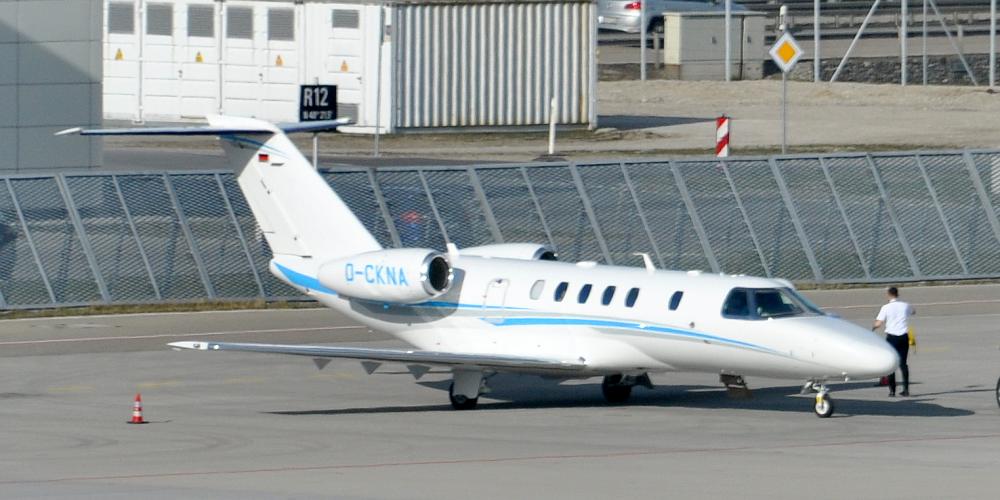
Cessna 525C CitationJet CJ4, registration D-CKNA, built 2012, serial number 525C-0108
Munich Airport (MUC/EDDM), Munich, Germany, 4 April 2018
150 | 172 |
182 | 206 |
208 | 210 |
310 |
318 |
336/337 Skymaster | O-2 |
340 |
402 | 421
Citation |
500/501 | 510 |
525 | 525A |
525B | 525C |
550 |
560 | 560XL |
650 | 680 |
680A | 750
Cessna 550 Citation II/Bravo
The Model 550 series of Citation jets are light corporate jet. A direct development of the Citation I (Model 510), the Citation II led to the later development of the Citation II/SP, the S550 Citation S/II, and the Citation Bravo.
By 1994, the Citation II and S/II had been in production for 10 years, and it was time to integrate new technology. Cessna thus announced the development of the Citation Bravo. While it was built on the basic II airframe, the new aircraft was powered by Pratt & Whitney Canada PW530A engines. The main landing gear was replaced by the smoother-riding trailing link configuration adopted by other members of the Citation line, and the standard avionics suite was updated to the Honeywell Primus 1000 glass cockpit. The new aircraft first flew on 25 April 1995, but certification did not come for over a year, finally being granted in August 1996. Production of the Bravo ceased in late 2006.

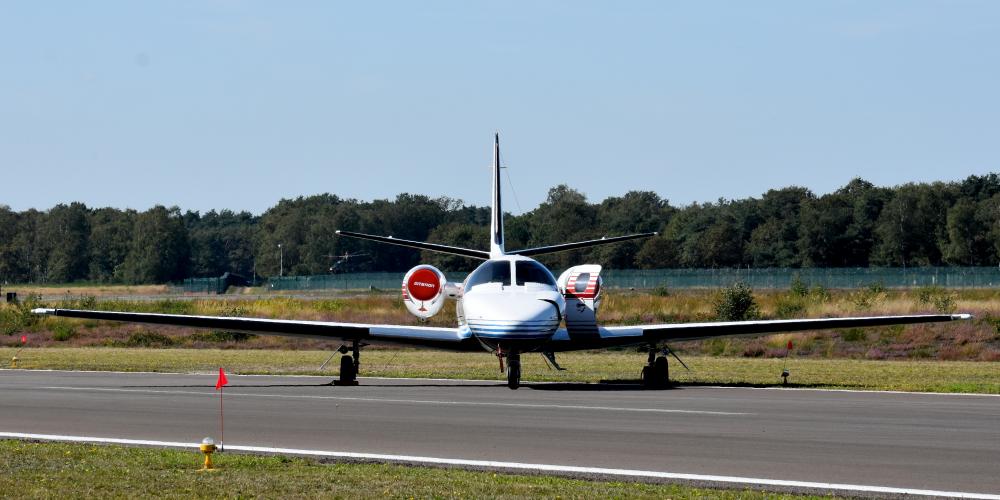
Cessna 550 Citation II/SP, registration OY-JEV, built 1981, serial number 550-0284
Vliegbasis Kleine-Brogel (EBBL), Peer, Belgium, 14 September 2019


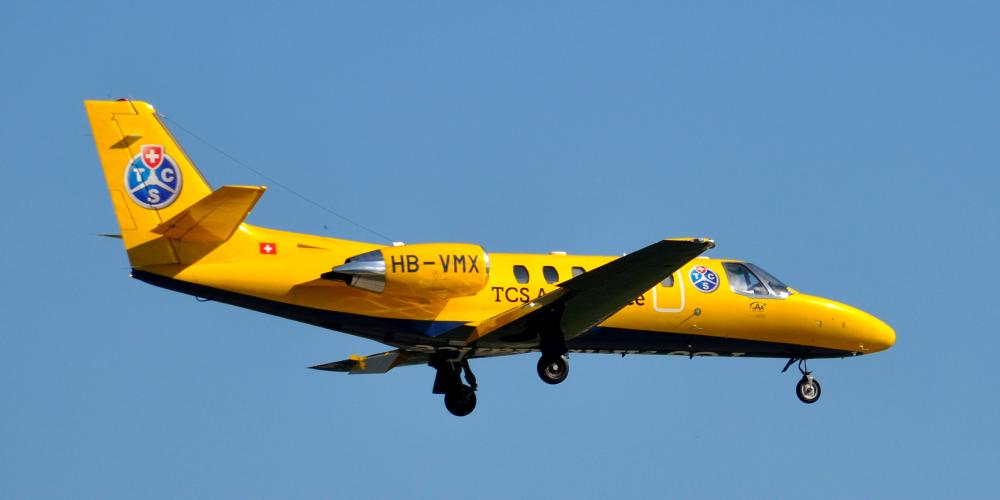
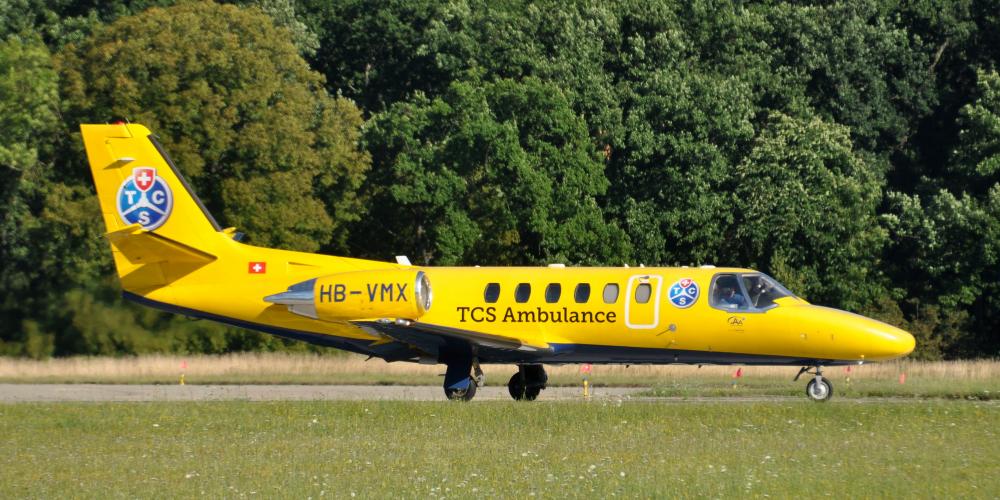
Cessna 550 Citation Bravo, registration HB-VMX, built 2000, serial number 550-0946
Cointrin (GVA), Geneva, Switzerland, 29 July 2016
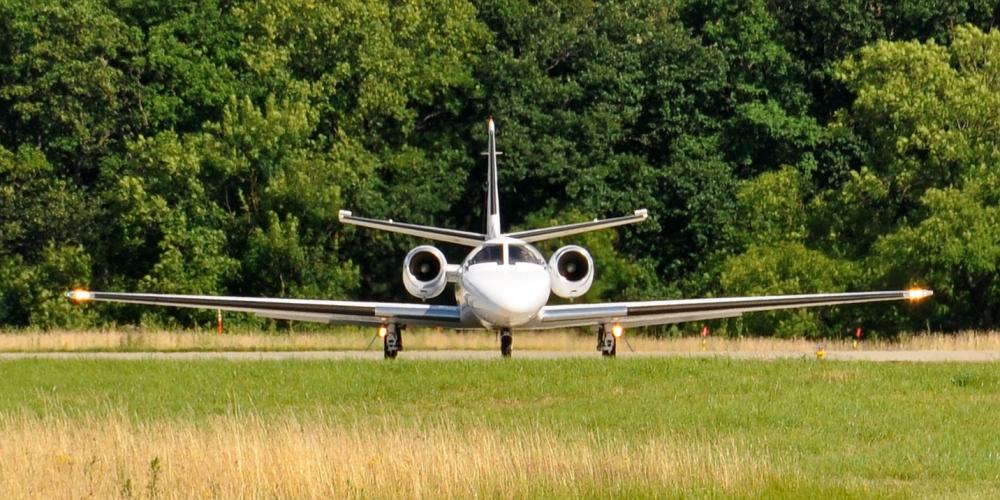
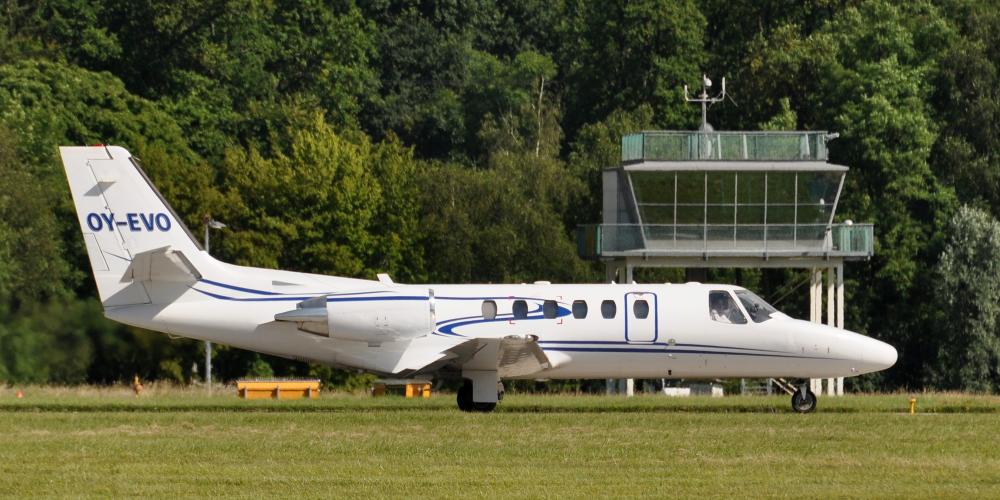
Cessna 550 Citation Bravo, registration OY-EVO, built 2003, serial number 550-1050
Cointrin (GVA), Geneva, Switzerland, 5 July 2016
150 | 172 |
182 | 206 |
208 | 210 |
310 |
318 |
336/337 Skymaster | O-2 |
340 |
402 | 421
Citation |
500/501 | 510 |
525 | 525A |
525B | 525C |
550 |
560 | 560XL |
650 | 680 |
680A | 750
Cessna 560 Citation Ultra/Encore
The Cessna Citation V (Model 560) is a turbofan-powered small-to-medium-sized business jet built in Wichita, Kansas. A stretch of the Cessna Citation II (Model 550) series, the Citation V aircraft was evolved into the Citation Ultra, the Citation Encore, and the Citation Encore+ models.
In 1993, Cessna decided to update the Citation V design, and announced the Citation Ultra. Powered by Pratt & Whittney JT15D-5D engines with 3045 lbs of thrust and the standard avionics suite, which was updated to the Honeywell Primus 1000 EFIS glass cockpit. The Primus 1000 replaced the standard "round dial" flight instruments with three CRT computer screens, one for each pilot and one center mulifunction display. The Ultra was produced from 1994–1999.
The UC-35A is the United States Army designation and UC-35C is the United States Marine Corps designation for the Citation Ultra, which replaced older versions of the Beechcraft C-12 Huron.


Cessna 560 Citation Ultra, registration HB-VNA, built 1994, serial number 560-0280
Cointrin (GVA/LSGG), Geneva, Switzerland, 7 May 2017
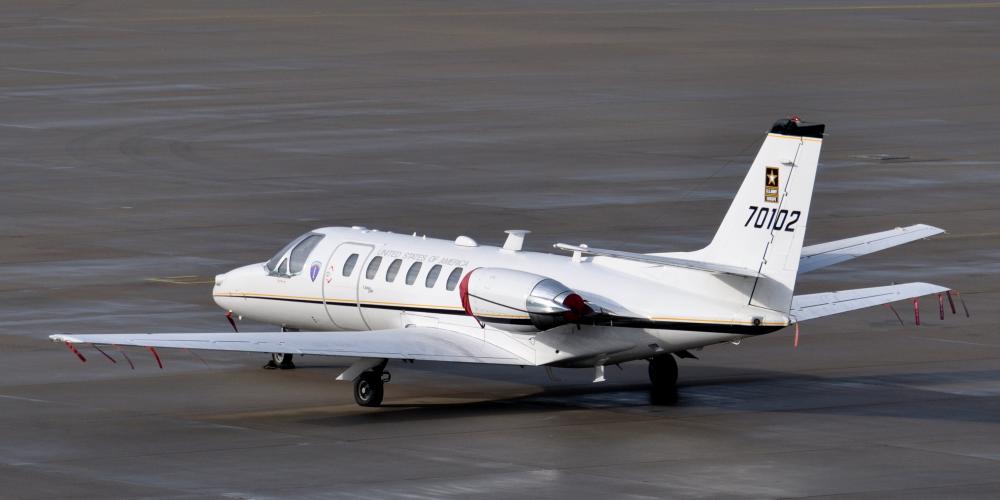
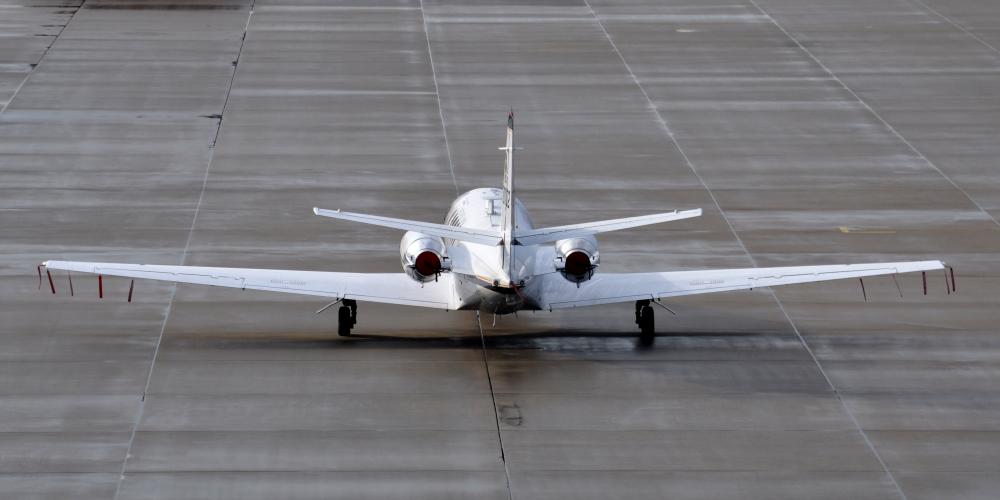

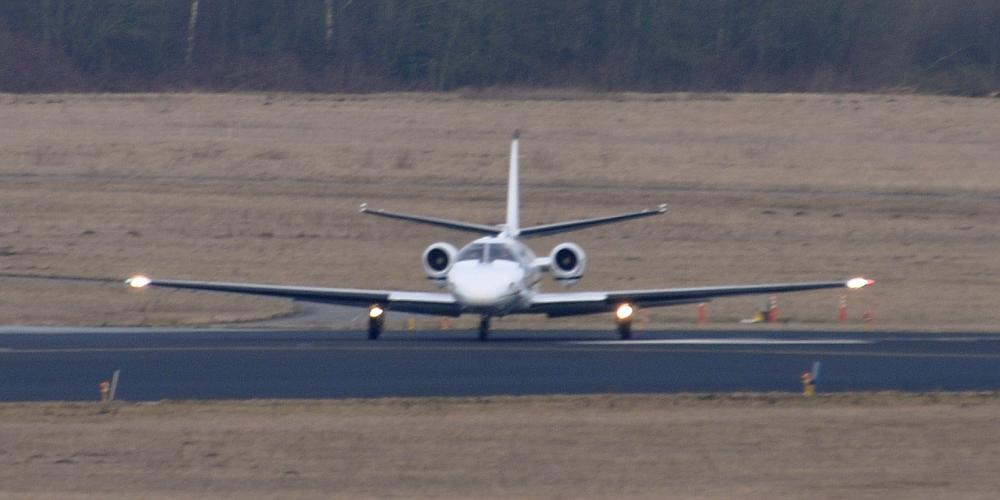
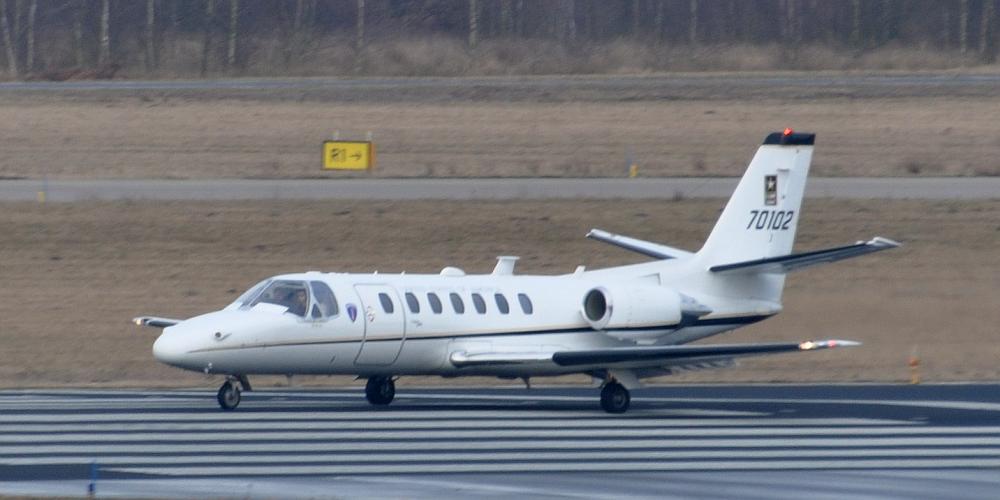
Cessna 560 Citation Ultra UC-35A, registration 97-0102, built 1997, serial number 560-0456
Eindhoven Airport (EIN), Eindhoven, Netherlands, 2 February 2017
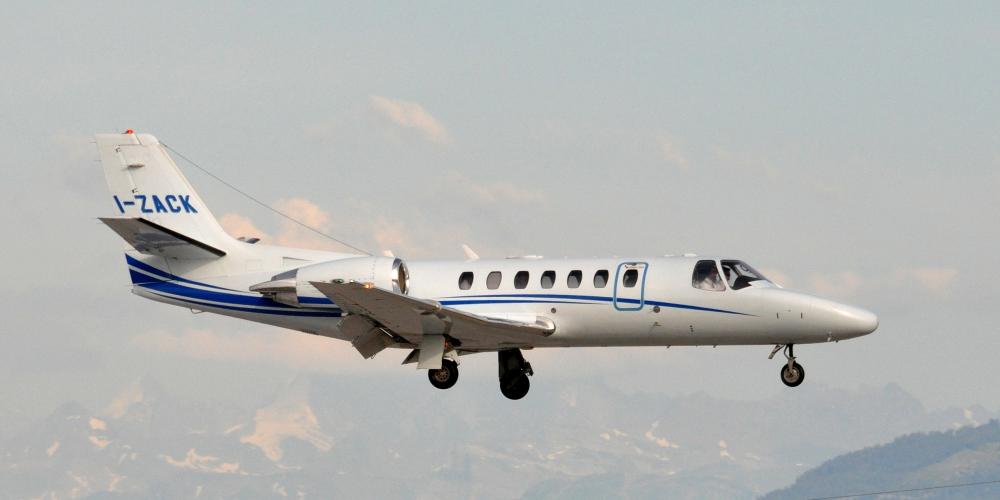
Cessna 560 Citation Encore+, registration I-ZACK, built 2007, serial number 560-0767
Cointrin (GVA/LSGG), Geneva, Switserland, 6 July 2017
150 | 172 |
182 | 206 |
208 | 210 |
310 |
318 |
336/337 Skymaster | O-2 |
340 |
402 | 421
Citation |
500/501 | 510 |
525 | 525A |
525B | 525C |
550 |
560 | 560XL |
650 | 680 |
680A | 750
Cessna 560XL Citation Excel/XLS/XLS+
The Cessna Citation Excel (Model 560XL) is a turbofan-powered, medium-sized business jet built in Wichita, Kansas, United States. A member of the wide-ranging Citation brand of business jets, the Excel was evolved into the Citation XLS and then the Citation XLS+ models.
The Citation Excel project was announced in October 1994 and the prototype aircraft took off on its first flight on 29 February 1996. FAA certification was granted in April 1998.
The Citation Excel was the original version of the Citation Excel series of aircraft. There were two cockpit configurations of the original model involving where the landing gear was on the panel. With the gear on the left hand side, the MFD was moved to the right slightly and both radios were moved to the right of the MFD next to each other. With the gear handle on the right side, the MFD remained centered with the radios on either side. The Excel uses Honeywell avionics and an optional Auxiliary power unit also powered by Honeywell.
The Citation XLS was the first "makeover" that the Excel received. Besides a glass cockpit based on the Honeywell Primus 1000 EFIS avionics suite, the XLS featured the upgraded PW545B engines with increased performance.
The Citation XLS+, or simply "Plus" configuration was the upgraded version of the aircraft, with the inclusion of FADEC engine controls, improved PW545C engines, and a completely revised nose design similar to that found on the Citation Sovereign and Citation X. The Citation XLS+ features Collins Pro Line 21 Avionics and a four screen LCD EFIS display as opposed to the three tube (CRT) Honeywell display in the XL and the three screen LCD Primus 1000 in the XLS.
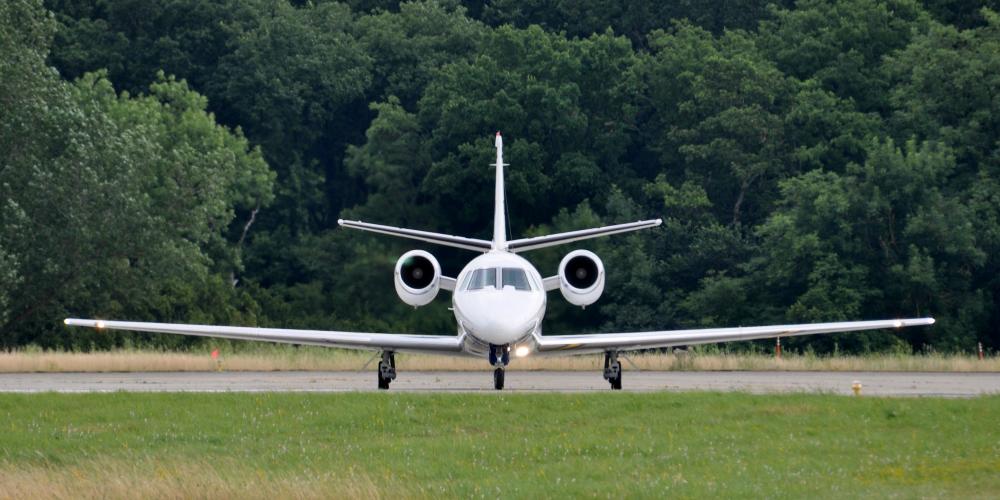

Cessna 560XL Citation Excel, registration OE-GUN, built 2000, serial number 560-5061
Cointrin (GVA), Geneva, Switzerland, 11 July 2016
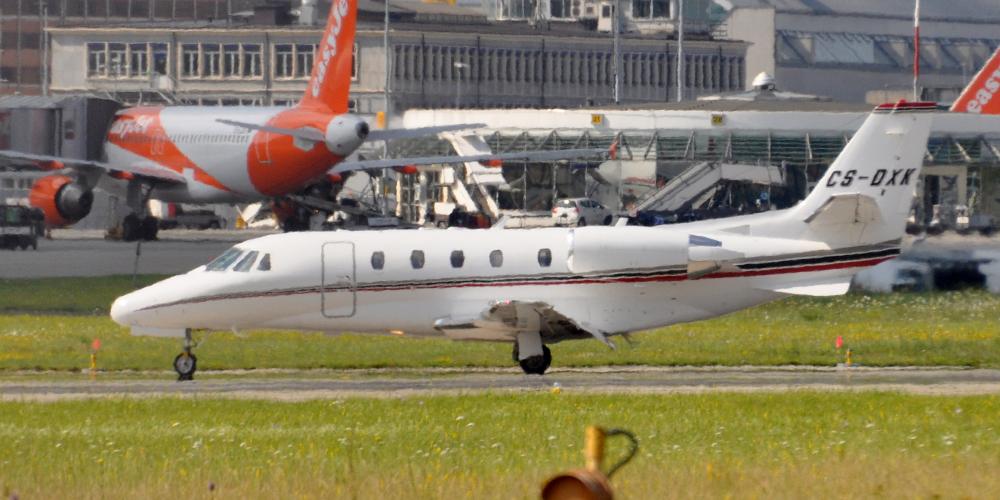
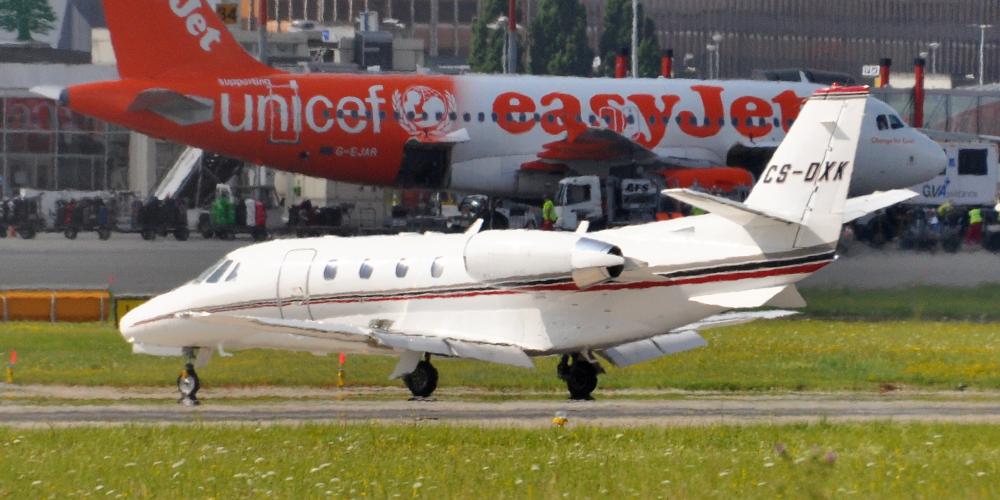
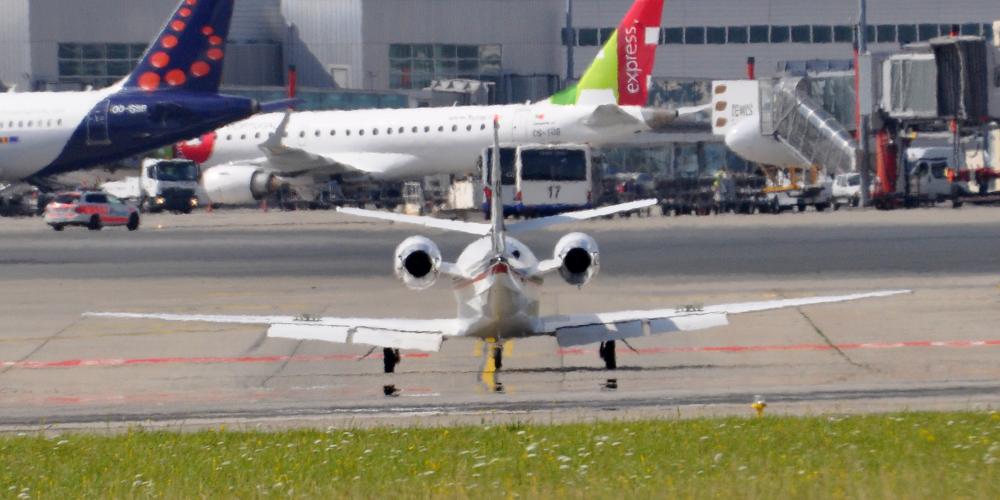
Cessna 560XL Citation XLS, registration CS-DXK, built 2006, serial number 560-5633
Cointrin (GVA), Geneva, Switzerland, 24 July 2016
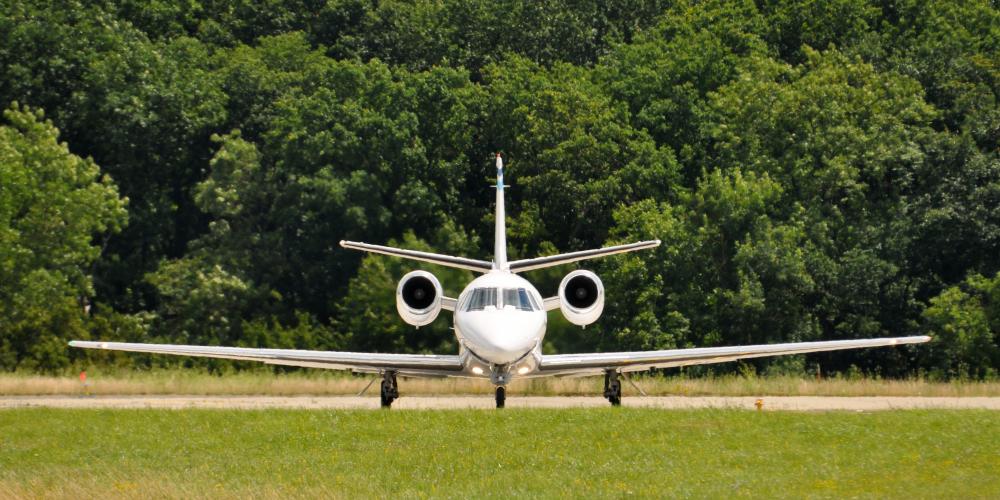
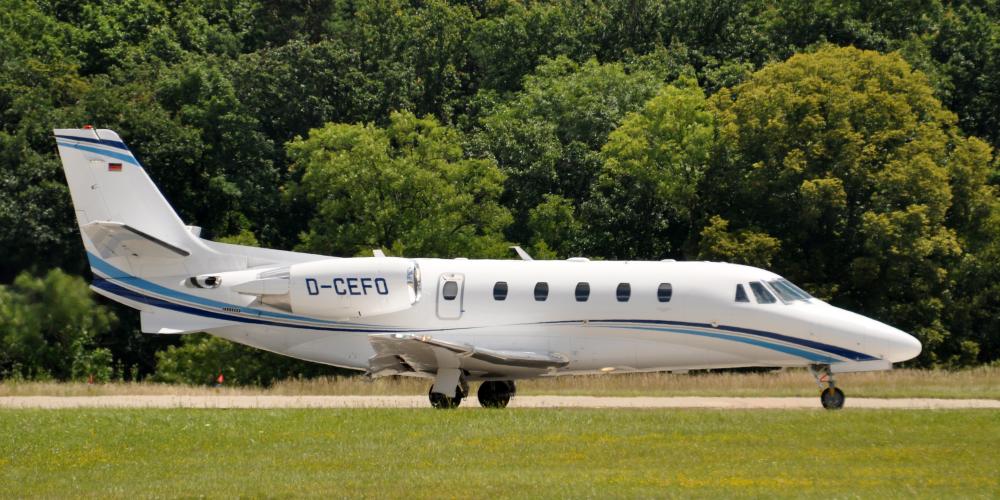
Cessna 560XL Citation XLS+, registration D-CEFO, built 2010, serial number 560-6082
Cointrin (GVA), Geneva, Switzerland, 13 July 2016
150 | 172 |
182 | 206 |
208 | 210 |
310 |
318 |
336/337 Skymaster | O-2 |
340 |
402 | 421
Citation |
500/501 | 510 |
525 | 525A |
525B | 525C |
550 |
560 | 560XL |
650 | 680 |
680A | 750
Cessna 650 Citation III/VI
The Cessna Citation III (Model 650) is a business jet with 2,350 nmi (4,350 km) of range and part of the Cessna Citation Family. Announced at the October 1976 NBAA convention, it made its maiden flight on May 30, 1979, received its type certification on April 30, 1982 and was delivered between 1983 and 1992. The cheaper Citation VI was produced from 1991 to 1995 and the more powerful Citation VII was offered between 1992 and 2000, 360 of all variants were delivered. An all new design, it had a 312 sq ft (29 sq m) swept wing for a 22,000 lb (10 t) MTOW, a T-tail and two 3,650–4,080 lbf (16.2–18.1 kN) TFE731 turbofans. Its fuselage cross section and cockpit were kept in the later Citation X, Citation Excel and Citation Sovereign.
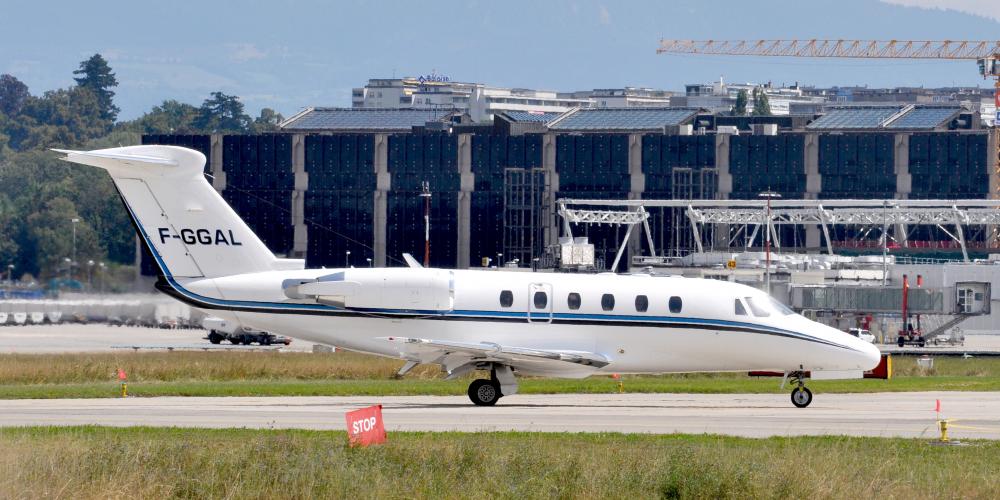
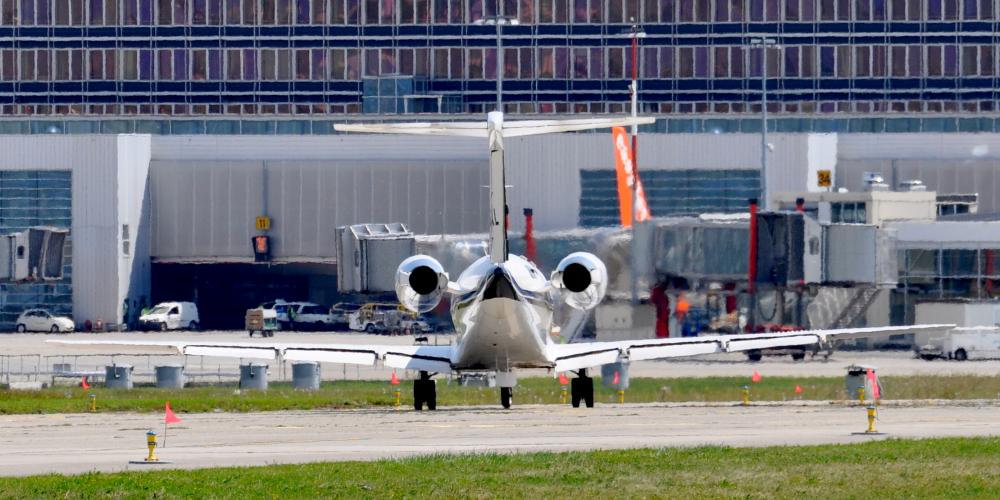
Cessna 650 Citation III, registration F-GGAL, built 1986, serial number 650-0117
Cointrin (GVA), Geneva, Switzerland, 18 August 2018
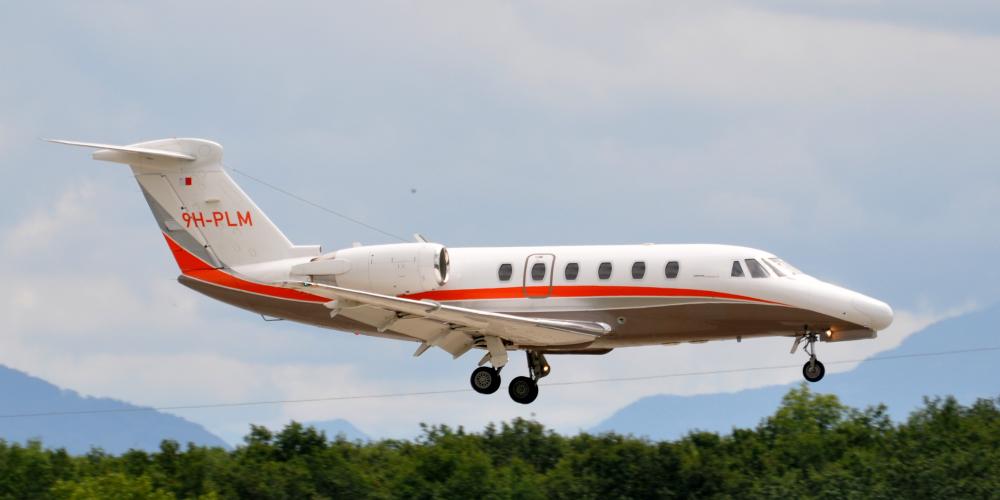
Cessna 650 Citation VI, registration 9H-PLM, built 1992, serial number 650-0217
Cointrin (GVA), Geneva, Switzerland, 21 July 2018
150 | 172 |
182 | 206 |
208 | 210 |
310 |
318 |
336/337 Skymaster | O-2 |
340 |
402 | 421
Citation |
500/501 | 510 |
525 | 525A |
525B | 525C |
550 |
560 | 560XL |
650 | 680 |
680A | 750
Cessna 680 Citation Sovereign
The Cessna Citation Sovereign (Model 680) is a mid-size business jet. It is currently the third largest member of the Citation product line in terms of take-off weight, with the Citation X and Citation Latitude having greater take-off weights.
In the late 1990s, Cessna saw the need for a high-performance jet midway between the Excel/XLS size and the Citation X. The result was the Model 680 Citation Sovereign, powered by two Pratt & Whitney Canada PW306C turbofan engines with FADEC controls. It uses the Honeywell Primus Epic glass cockpit avionics suite, coupled with dual Honeywell FMZ2000 FMS units. Its claim to fame is that it can take off and land in short distances, thanks to a moderately swept high aspect ratio wing, and (when light) 92 knot Vref speed. It was first unveiled to the public in 1998 at the NBAA exhibition in Las Vegas, Nevada. The Sovereign seats eight passengers in a typical cabin configuration, with a maximum high-density capacity of 12, in addition to the crew of two. First flight of the Sovereign took place in February, 2002, with FAA certification awarded in June, 2004. Customer deliveries began later that year. EASA certification came in June 2014.
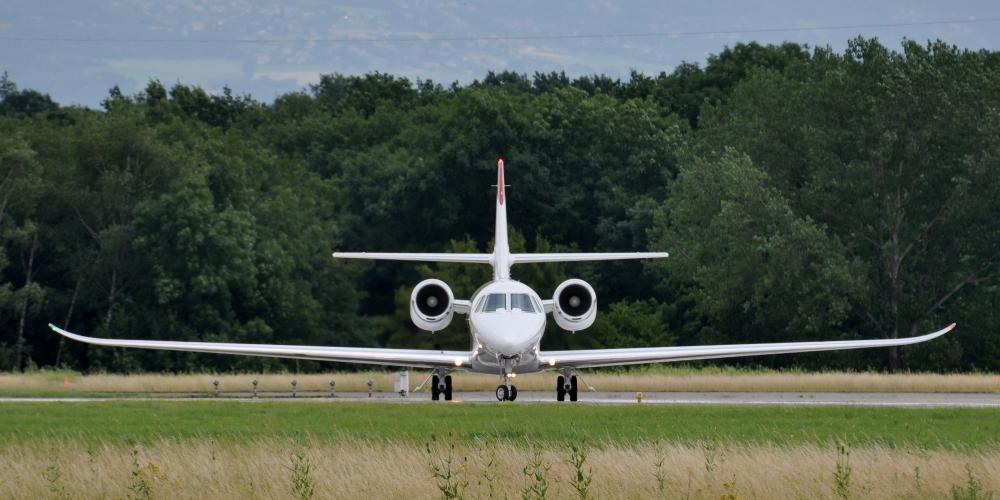
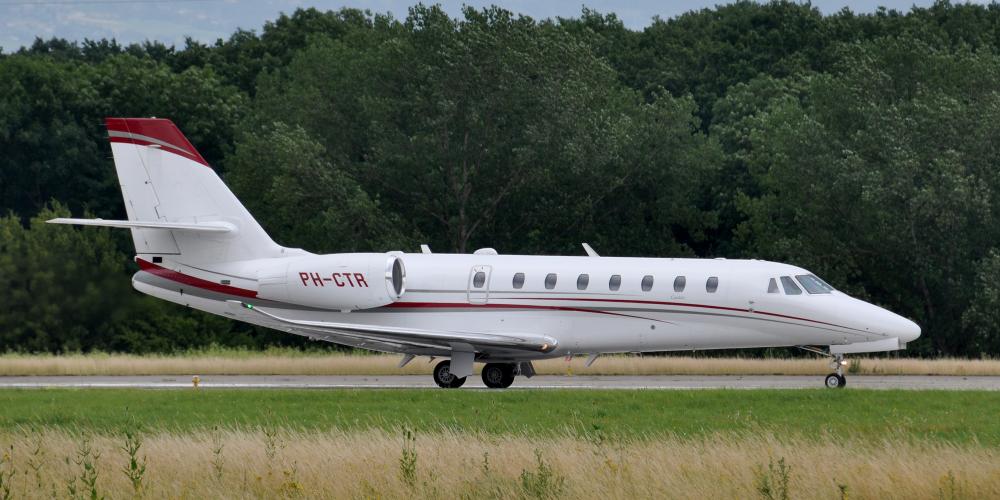
Cessna 680 Citation Sovereign, registration PH-CTR, built 2014, serial number 680-0525
Cointrin (GVA), Geneva, Switzerland, 11 July 2016
150 | 172 |
182 | 206 |
208 | 210 |
310 |
318 |
336/337 Skymaster | O-2 |
340 |
402 | 421
Citation |
500/501 | 510 |
525 | 525A |
525B | 525C |
550 |
560 | 560XL |
650 | 680 |
680A | 750
Cessna (Textron) 680A Citation Latitude
The Cessna Citation Latitude (Model 680A) is a mid-size jet, derived from Cessna's Model 680 Sovereign. It was type certified by the Federal Aviation Administration (FAA) in June 2015.

Textron Aviation 680A Citation Latitude, registration CS-LTB, built 2016, serial number 680A0050
Cointrin (GVA), Geneva, Switzerland, 3 July 2017
150 | 172 |
182 | 206 |
208 | 210 |
310 |
318 |
336/337 Skymaster | O-2 |
340 |
402 | 421
Citation |
500/501 | 510 |
525 | 525A |
525B | 525C |
550 |
560 | 560XL |
650 | 680 |
680A | 750
Cessna 750 Citation X
The Cessna Citation X is a long-range medium-sized business jet aircraft. The Citation X is powered by two turbofan engines and is built in Wichita, Kansas.
When the Citation X was announced, the Citation 650 series, the "family" at the top of the product line, which includes the Citations III, VI, and VII, was eight years old. The development of the Citation X was first announced at the National Business Aviation Association Convention in New Orleans in October 1990, with the first prototype making its maiden flight on December 21, 1993. The certification of the Cessna Citation X was delayed several times and postponed to late November 1995. The first Citation X was delivered in July 1996 to golfer and long-time Cessna customer Arnold Palmer.

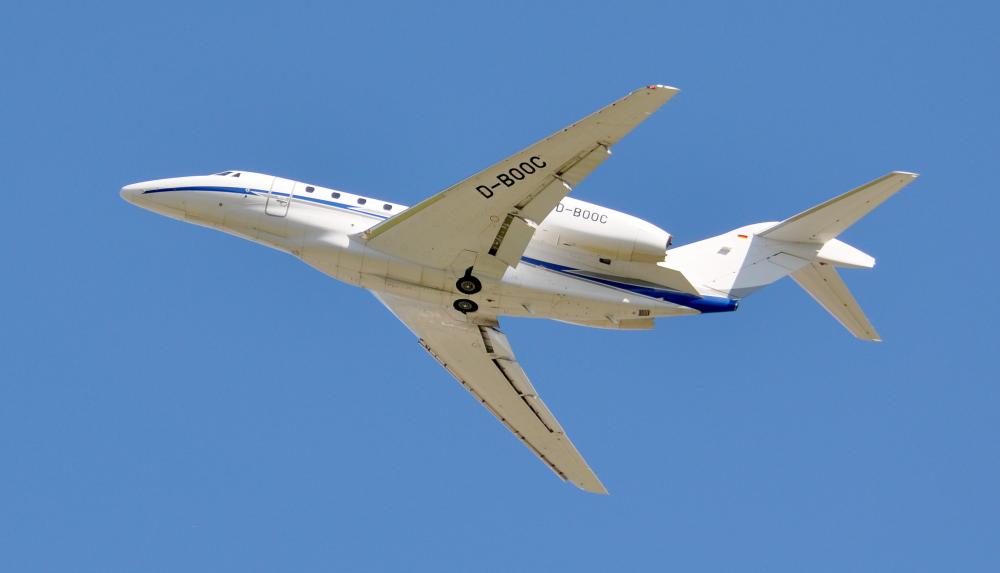
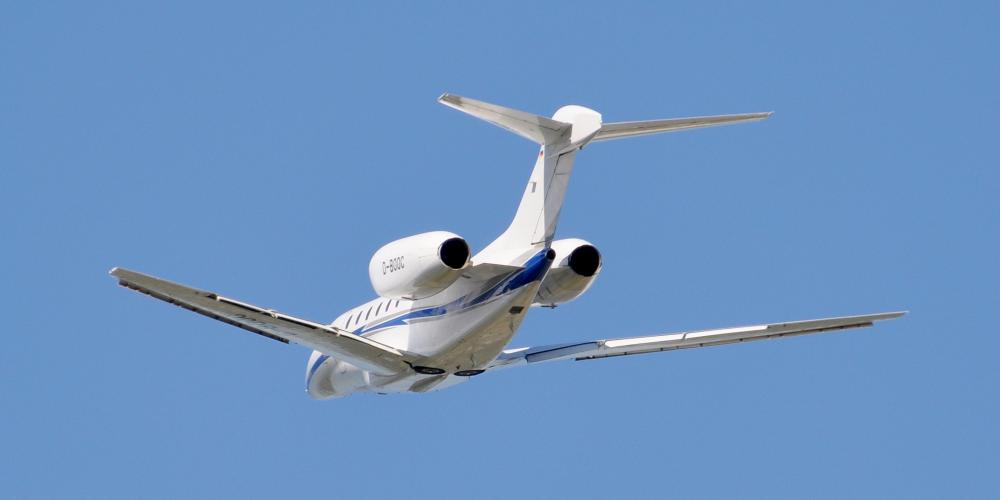
Cessna 750 Citation X, registration D-BOOC, built 2006, serial number 750-0259
Cointrin (GVA), Geneva, Switzerland, 18 July 2016
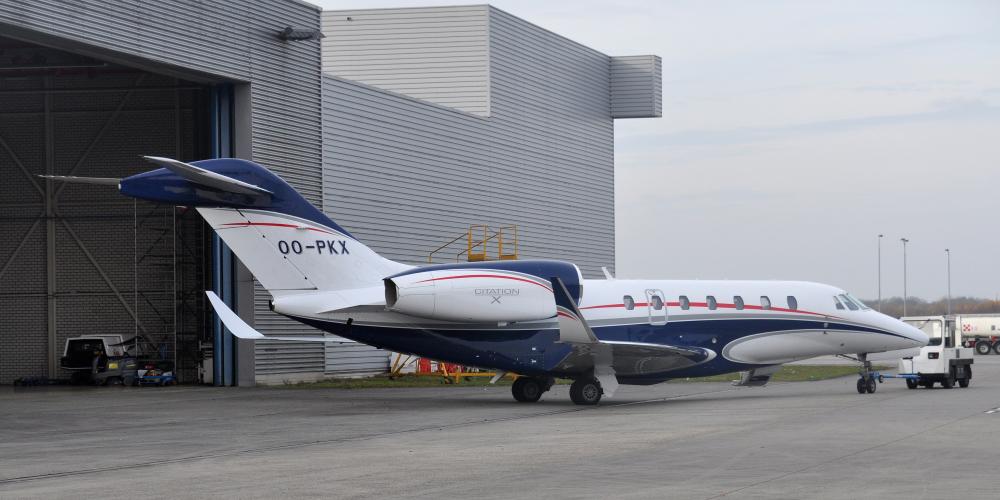
Cessna 750 Citation X, registration OO-PKX, built 2012, serial number 750-0313
Eindhoven Airport (EIN), Eindhoven, Netherlands, 24 November 2016
150 | 172 |
182 | 206 |
208 | 210 |
310 |
318 |
336/337 Skymaster | O-2 |
340 |
402 | 421
Citation |
500/501 | 510 |
525 | 525A |
525B | 525C |
550 |
560 | 560XL |
650 | 680 |
680A | 750
|






















































































